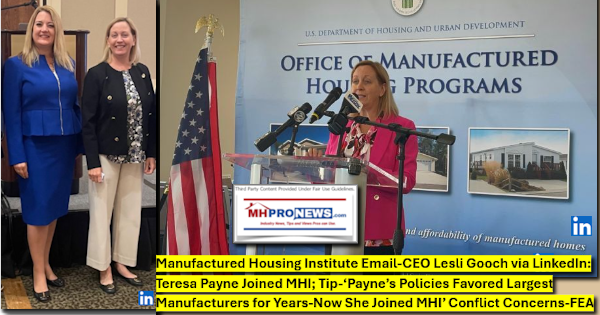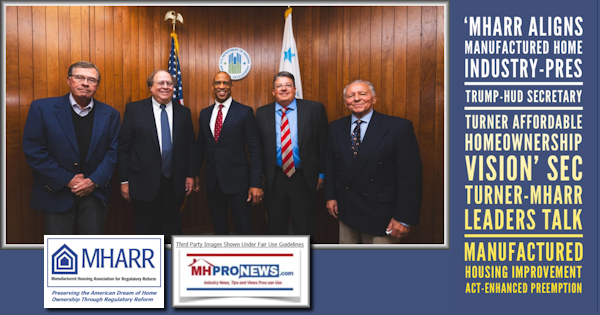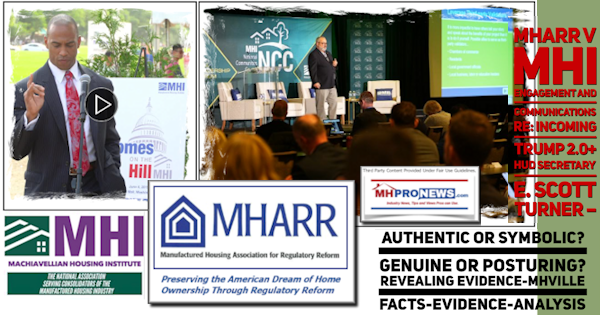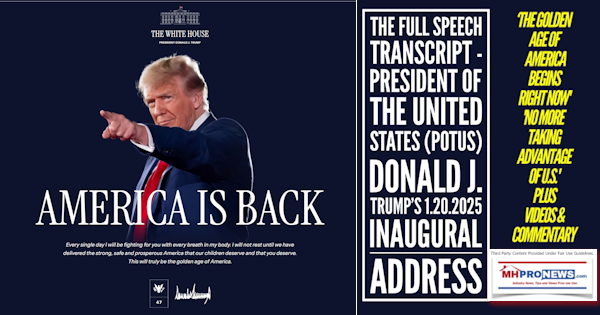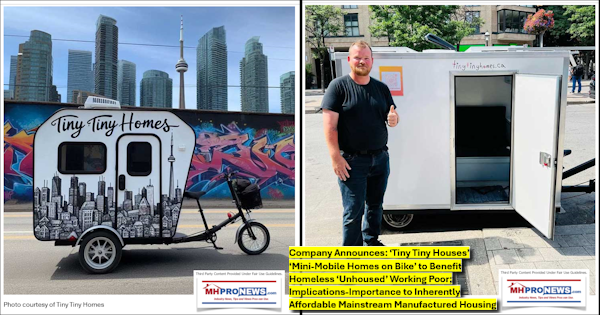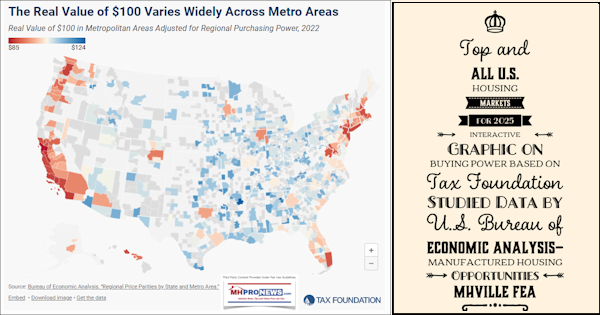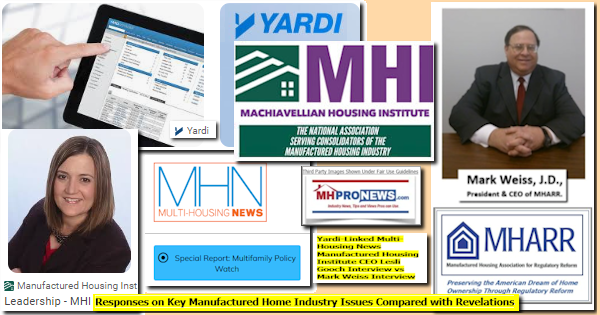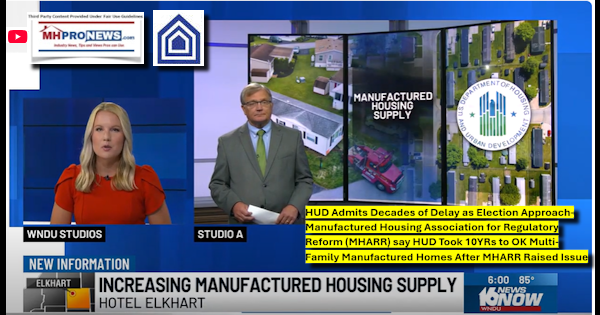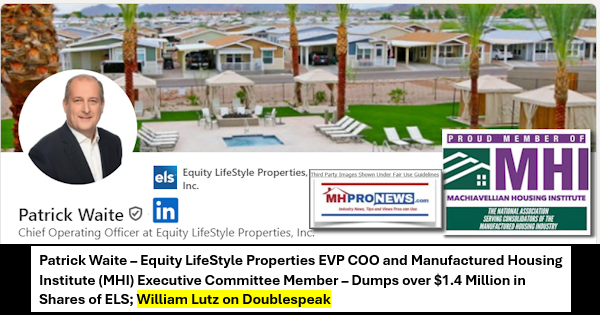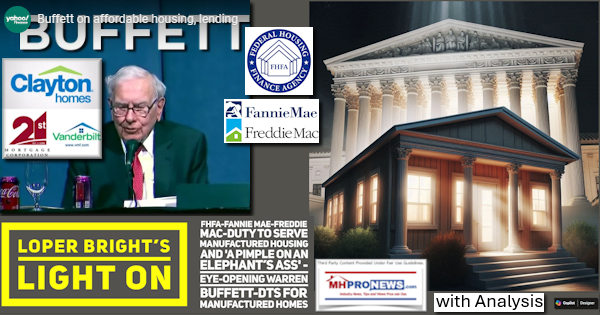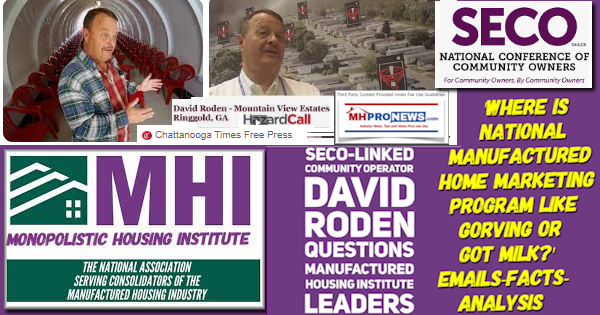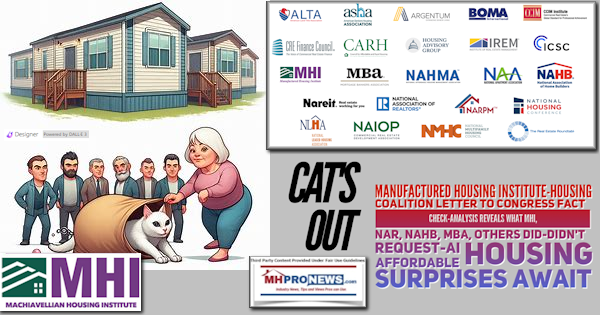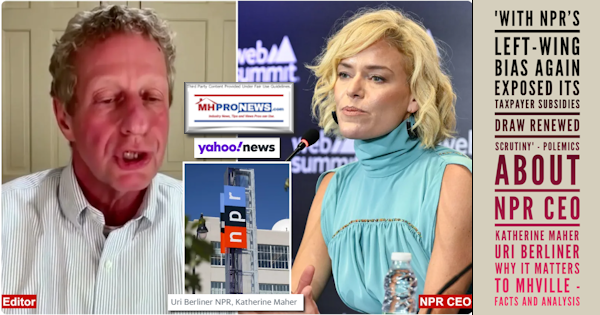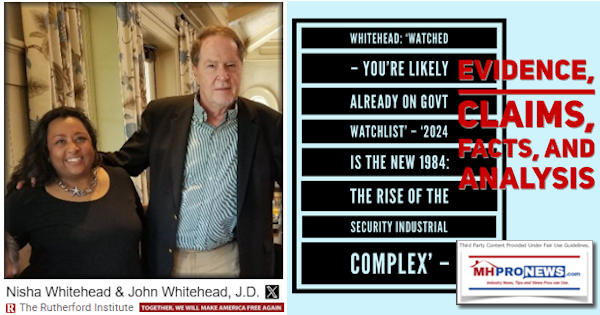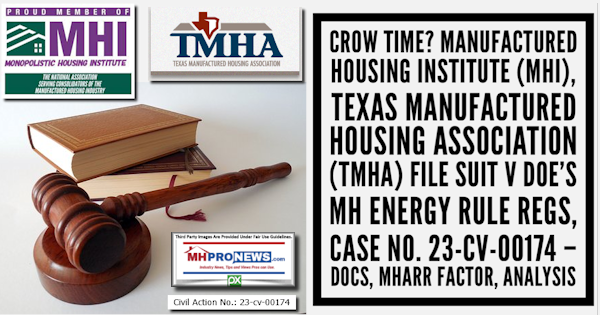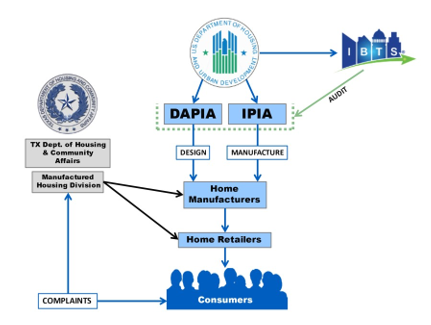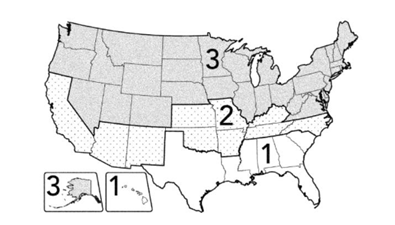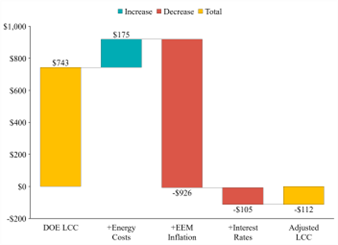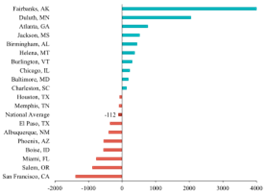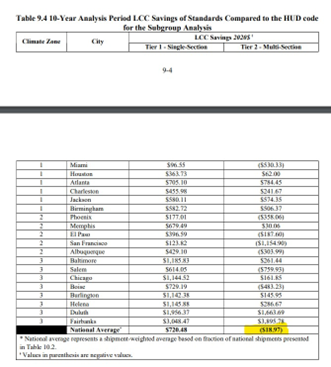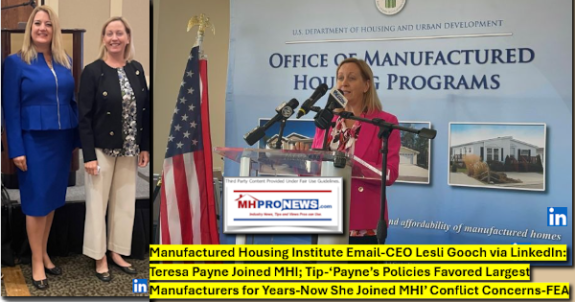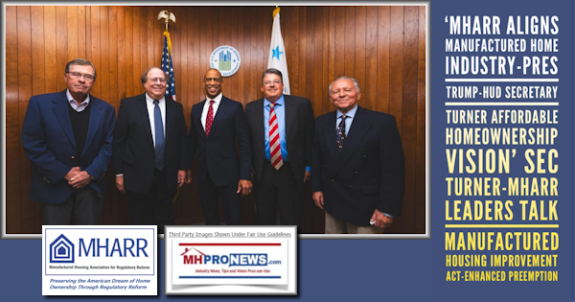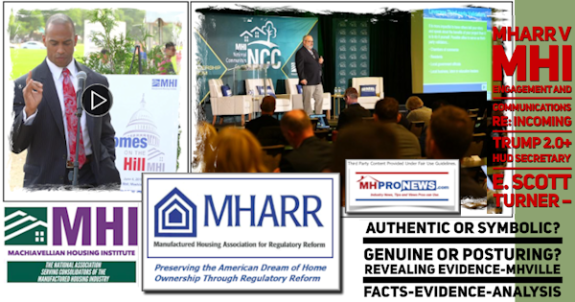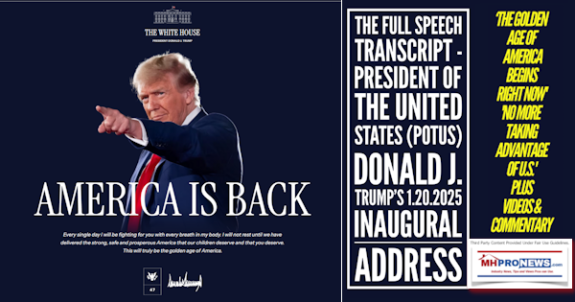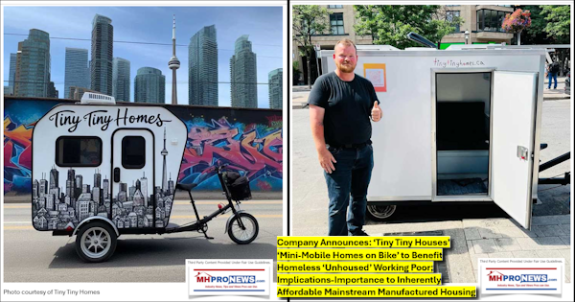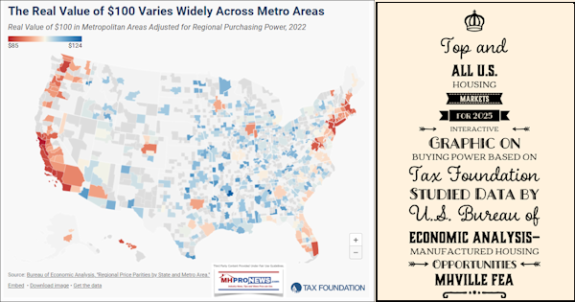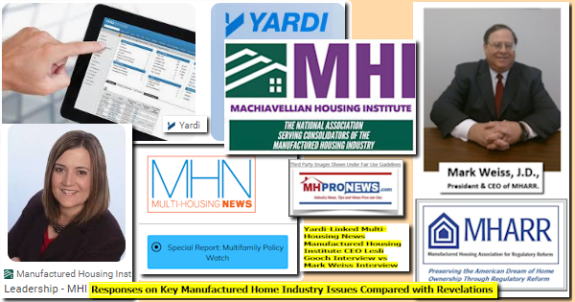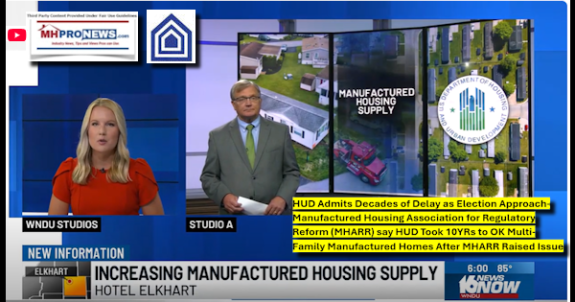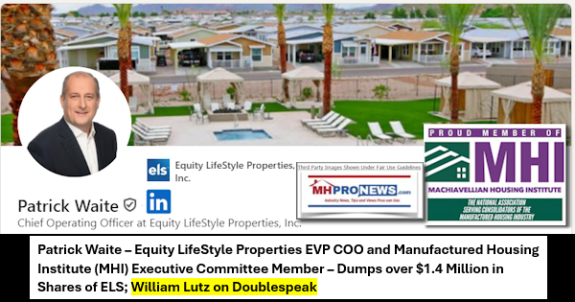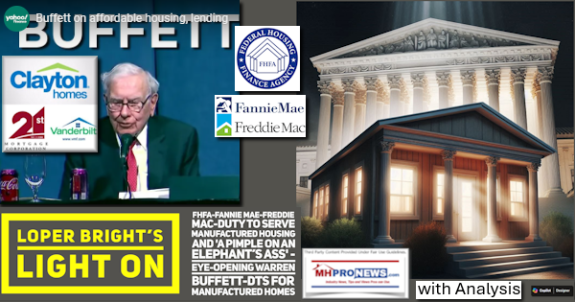‘Happy Valentine’s Day’ to the Department of Energy was not mentioned in the Manufactured Housing Institute (MHI) legal pleadings opposing the Department of Energy (DOE) manufactured housing energy standard regulations in a suit filed in association with the Texas Manufactured Housing Association (TMHA). Nor were their pleadings’ pending filing mentioned in the MHI generated “Federated States” ‘newsletter’ to their ‘affiliated’ state associations emailed on 2.13.2023. The MHARR Factor – what a prior MHI chairman indicated was the ‘elephant in the room’ – will be explored herein as an influence on MHI and the TMHA’s potentially important step, as the Manufactured Housing Association for Regulatory Reform (MHARR) has been consistently calling for litigation by MHI since the DOE issued their ‘final rule’ last year. Similarly, this platform and our MHLivingNews sister site have consistently highlighted for months the lack of litigation by MHI on this and other nagging issues that are arguably harming manufactured housing industry producers, sellers, consumers, taxpayers, and others.
If MHI was more transparent in years gone by, those years have obviously since gone by. When MHI doesn’t inform their own readers/members/affiliates in writing through their emailed ‘newsletter’ the day before their suit is filed, well, shouldn’t that be flagged as a problem? More on that further below, in Part II of this report. Part II will include additional information with more facts, information and expert analysis in this Masthead editorial on MHProNews.
That noted, it is potentially a good thing that MHI has filed suit.
The MHI/TMHA pleadings include the claim that over 50,000 new manufactured homes may not be sold or built due to the pending DOE ‘final rule’ energy standards.
MHI’s outside attorneys argued that that the rule will harm minorities and all financially marginal buyers more than more affluent ones.
If successful, MHI should be given a qualified kudos. Either way, MHARR absolutely merits praise for exposing several of the apparently duplicitous steps taken by MHI, which MHProNews has consistently exposed to the largest professional trade audience in MHVille.
With that backdrop, and a promising potential pivot by MHI which suggests that they may finally be doing their job to represent “all segments” of manufactured housing, in Part I below are the main pleadings and the TRO (Temporary Restraining Order) filed against the DOE.
Part I.
a. MHI-TMHA primary federal court filing.
Case 1:23-cv-00174 Document 1 Filed 02/14/23 Page 1 of 46
IN THE UNITED STATES DISTRICT COURT FOR THE WESTERN DISTRICT OF TEXAS
)
THE MANUFACTURED HOUSING )
INSTITUTE; and THE TEXAS )
MANUFACTURED HOUSING )
ASSOCIATION, )
) Civil Action No.: 1:23-cv-00174
Plaintiffs, )
)
- )
)
THE UNITED STATES )
DEPARTMENT OF ENERGY; and )
JENNIFER M. GRANHOLM, )
Secretary of the United States )
Department of Energy in her official )
capacity only, )
)
Defendants. )
PLAINTIFFS’ ORIGINAL COMPLAINT SEEKING TEMPORARY AND PERMANENT DECLARATORY AND STAY/INJUNCTIVE RELIEF UNDER THE APA
TO THE HONORABLE UNITED STATES DISTRICT JUDGE:
Plaintiffs the Manufactured Housing Institute (“MHI”) and the Texas Manufactured
Housing Association (“TMHA”), both trade associations representing all segments of the manufactured housing industry, bring this action for declaratory and injunctive relief.
SUMMARY
Plaintiffs challenge the Department of Energy’s (“DOE”) recent promulgation of energy standards for manufactured housing in its May 31, 2022 Final Rule, titled “Energy Conservation
Program: Energy Conservation Standards for Manufactured Housing.” 87 Fed. Reg. 32,728 (the “Final Rule”). Plaintiffs timely make this challenge in advance of the Final Rule’s upcoming May
31, 2023 compliance date, and contemporaneously with this Complaint file a Motion to Stay in accordance with 5 U.S.C. § 705 because that compliance date is arbitrary, capricious, and impracticable. DOE promulgated the Final Rule in contravention of its Congressional mandate to consult with HUD, the primary federal agency setting standards through an extensive regulatory structure, and which has over 50 years of experience regulating the manufactured housing industry.
Some aspects of this regulatory structure are described infra and are illustrated as follows:
The manufactured housing industry is an avid proponent of energy conservation efforts.
The industry’s manufacturers are pioneers in the development of construction processes that value and prioritize energy efficiency. Manufacturers are constantly developing new initiatives and technologies, such as comprehensive recycling programs, to reduce waste. Through the controlled environment of the factory-built process, manufacturers are able to use exact dimensions and measurements for most building materials. Today’s modern manufacturing plants are so efficient that nearly everything is reused or recycled, including cardboard, plastic, carpet padding, vinyl siding, scrap wood and much more. Similarly, with regard to consumers, a recent study of residential energy consumption showed that existing manufactured homes consume the least energy of all types of homes. In 2020, more than 30% of new manufactured homes met or exceeded Energy Star efficiency standards.[1]
According to a recent Freddie Mac study, “[e]nergy efficiency built into the homes themselves and an eco-friendly manufacturing process mean manufactured homes far surpass sitebuilt in terms of their environmental footprint. The factory home building process produces a fraction of the waste compared to a site-built home.”[2]
While the manufactured housing industry as a whole is an active proponent of energy conservation and efficiency, to ensure that manufactured homes remain the most affordable, unsubsidized housing option in today’s market, energy standards must be accurately balanced against their implementation costs. The Final Rule falls woefully short of striking a rational balance between energy conservation and affordable housing. And DOE failed to comply with its requirement to consult with HUD. In sum, the Final Rule is contrary to the law and is in violation of both the Administrative Procedures Act (the “APA”), 5 U.S.C. § 551, et seq., and the Final
Rule’s enabling legislation, the Energy Independence and Security Act of 2007 (the “EISA”), 42 U.S.C. § 17071.
INTRODUCTION
- The Department of Energy regulates various aspects of the nation’s energy practices. In the EISA, Congress authorized DOE to “establish standards for energy efficiency in manufactured housing.” 42 U.S.C. § 17071(a)(1).
- In the Final Rule, DOE sought to carry out its mandate under the EISA to promulgate energy standards for manufactured housing. But DOE failed to comply with its legislative mandate under the EISA—and, moreover, DOE’s Final Rule is arbitrary and capricious in violation of the APA.
- First, in preparing the energy standards for manufactured housing, DOE failed to consider all relevant costs that affect the purchase price of manufactured homes and the total lifecycle construction and operating costs for consumers. The EISA explicitly directs DOE to ensure that its energy standards for manufactured housing are “cost-effective,” taking into account the standards’ impact “on the purchase price of manufactured housing and on total life-cycle construction and operating costs.” 42 U.S.C. § 17071(b)(1). Openly shirking this mandate, DOE readily admits in the Final Rule that it has “not included any potential associated costs of testing, compliance or enforcement at this time.” 87 Fed. Reg. at 32,758. Obviously, testing, compliance, and enforcement (and their associated costs) are integral to both energy standards and construction materials and techniques. Testing, compliance, and enforcement will indisputably and materially increase construction costs of manufactured homes and thereby the purchase price for each manufactured home. DOE wholly ignored these costs in direct contravention of the EISA. For example, potential costs of duct-leakage testing alone have been estimated to be as high as $1,500 per home, far above DOE’s original estimates of consumer savings for single-section and multi-
section homes over the 10-year analysis period.
- Relatedly, compliance with the Final Rule will require manufacturers to purchase substantial additional construction materials such as fiberglass insulation. DOE’s methodology has completely ignored recent economic realities including the actual costs of construction materials.
In 2022, DOE arbitrarily used outdated 2014 materials cost estimates (instead of recent and actual construction costs) and assumed a hypothetical nominal annual cost increase of 2.3% between 2014 and 2023. Even if this abstract economic model approach could be understandable in some ordinary times or in a college course, this assumption willfully ignores the realities of this remarkable decade and the current macro-economic factors. The DOE’s approach fails to comport with the dramatic actual cost increases to building and manufacturing materials caused by the
Covid-19 pandemic and a series of historic natural disaster events like hurricanes that have hit the United States since 2014 that have created massive economic disruptions to supply chains and home construction. As was well-known at the time DOE promulgated the Final Rule in May 2022, the cost of construction materials has actually increased by 6.5% annually between 2014 and 2021—driven mostly by cost increases of an astonishing 35.1% from 2020 to 2021. DOE wholly ignored these actual cost increases for construction materials contrary to its legislative mandate.
- For example, using DOE’s own modeling but accounting for actual economic realities, DOE’s conclusion of net benefits of $743 over a 10-year period to multi-section homebuyers is reversed, and Final Rule will result in a net cost of -$112 to the average multi section homebuyer over DOE’s 10-year analysis period. And nearly all (98 percent) of borrowers using a personal property loan to finance a multi-section home purchase would face net costs over a 10-year horizon.
- DOE also failed to account for the nation’s dire supply chain shortages and just
assumed, without any support, that all new materials would be readily available to manufacturers.
- The real consequences of the faulty assumptions and other problems with the
DOE’s methodology and non-compliance with the APA mean that the Final Rule—if allowed to be implemented and enforced by May of 2023—will cause substantial disruption to homebuyers and Plaintiffs’ members among many others. Based on purchase price increases, economists estimate that the Final Rule could lead to between 1,703 and 5,101 fewer manufactured home sales each year over the next ten years (for a total of between 17,030 and 51,010 fewer homes). Worse still, some number of those families may be left with no housing at all, exacerbating and compounding the nation’s affordable housing crisis. Equally as important, economists estimate that the Final Rule will disparately impact the lowest income and historically underrepresented groups by rendering home ownership even further from their reach.
- Second, the Final Rule is arbitrary and capricious in its one-year compliance deadline. In the Final Rule, DOE demands that manufacturers fully comply with its sweeping changes to energy standards by May 31, 2023, a mere one year after the date on which DOE published the new standards. This aggressively short compliance window is unrealistic and arbitrary. The Final Rule will require manufacturers across the manufactured housing industry to redesign every home model—of which there are thousands. Manufacturers must source the new materials required to comply with the Final Rule during a global supply chain crisis. It is patently unreasonable and unjust for DOE to demand these seismic industry shifts in just 12 months. DOE typically allows appliance manufacturers five (5) years to comply with new energy standards. Constructing an entire manufactured home is certainly more complicated than constructing an appliance.
- Third, in contravention of another of the EISA’s requirements and critical to the problems that have forced Plaintiffs to file this lawsuit, DOE failed to consult with HUD about the
Final Rule’s energy standards. The EISA required DOE to bring the specific standards it was contemplating to HUD so that DOE could benefit from HUD’s long-standing familiarity and expertise in regulating the construction and affordability of manufactured homes. DOE never did so. At best, in the Final Rule, DOE states in cursory fashion that it did “consult” with HUD. That perfunctory, conclusory claim is insufficient as a matter of law. The administrative record must reveal actual, substantive consultation with HUD in the development of DOE’s energy standards. Tellingly, in response to FOIA requests on behalf of Plaintiffs for any evidence of consultation, DOE has refused to produce any information at all, much less any information that could substantiate any manner in which DOE discharged its lawful obligations. Where, as here, there is no such evidence, the Final Rule should be set aside.
- DOE’s Final Rule has unnecessarily caused conflict with the leading federal agency involved in extensively regulating the manufactured home industry, HUD. In the Manufactured
Housing Improvement Act of 2000, Congress established the Manufactured Housing Consensus Committee (“MHCC”)—a statutory Federal Advisory Committee body charged with providing recommendations to the HUD Secretary on the revision and interpretation of HUD’s manufactured home construction and safety standards and related procedural and enforcement regulations.
Because of HUD’s long-standing experience in this area, the EISA required DOE to consult with
HUD. However, in promulgating the Final Rule, DOE did not consult with HUD or the MHCC. After DOE promulgated the Final Rule, in October and November of 2022, the MHCC convened to review and analyze the Final Rule, and concluded, inter alia, that:
- The MHCC has reviewed the DOE Final Rule and has determined DOE circumvented the standards development process prescribed in EISA which requires cost justification and consultation with HUD.
- DOE provided an energy conservation standard which was based on site built construction and applied it to a performance-based national code. If adopted as written, the Final Rule would adversely impact the entire
Manufactured Housing program and cost increases associated with
compliance would reduce prospective purchasers (especially minorities and low-income consumers) from durable, safe, high quality and affordable housing.
- The MHCC previously recommended that DOE include the substantial cost of testing, enforcement, and regulatory compliance in its costing analysis.
The Final Rule did not consider these costs.
MHCC Working Document from October and November 2022 MHCC Meetings, at 1–2 (emphasis
added).[3]
- The manufactured housing industry values improvements in energy efficiency. Indeed, the industry and its factory construction methods are at the forefront of such innovations. But the statutory mandate under which DOE promulgated its energy standards for manufactured housing quite sensibly requires that DOE balance energy efficiency together with other goals, chief among them the goal of ensuring that affordable housing is broadly available to those who would otherwise lack the ability to pursue homeownership. DOE’s Final Rule is out of step with, and in practice undermines, these goals. Indeed, if allowed to go into effect, as mentioned above, it will cause disproportionate harm to historically underrepresented groups within the manufactured housing market.
- Given these defects in DOE’s rulemaking, Plaintiffs ask this Court to declare that the Final Rule is unlawful, set aside the Final Rule, and stay or enjoin DOE from implementing it.
PARTIES
- Plaintiff MHI is the only national trade organization representing all segments of the factory-built housing industry. MHI’s members include home builders, retailers, community operators, lenders, suppliers, and affiliated state organizations. MHI’s members produce approximately 85% of the manufactured homes constructed each year. MHI is an Illinois not-for-profit corporation with headquarters in Arlington, Virginia.
- MHI works to promote fair laws and regulations, increase and improve financing options, provide technical analysis and research, promote industry professionalism, remove zoning barriers, and educate external audiences about the benefits of manufactured housing. Through these various programs and activities, MHI seeks to promote the use of manufactured housing to consumers, developers, lenders, community operators, insurers, the media and public officials so that more Americans can realize their dream of homeownership.
- MHI has a substantial interest in this action. MHI is focused on maintaining the affordability of manufactured housing to serve lower-income home purchasers. DOE’s Final Rule puts the affordable nature of manufactured housing at substantial risk because the Final Rule failed to consider the actual costs associated with implementation. Additionally, MHI is also focused on the stability of the manufactured housing industry, and the Final Rule introduces significant uncertainty to the industry. By way of example only, the Final Rule requires various new energy efficiency standards, but the Final Rule fails to offer any testing procedures for those standards. The manufactured housing industry faces grave uncertainty complying with energy standards when the industry does not know what testing procedures for those standards DOE will accept assatisfactory.
- Plaintiff TMHA has served Texas’ manufactured housing industry since 1952. TMHA is concerned with the entire scope of the Texas manufactured housing industry. The association represents over 1,400 company members from every facet of the industry, including manufacturers, retailers, communities, insurance companies, suppliers of goods and services, salespeople, real estate companies, title companies, developers, transporters, installers, financial institutions, brokers, and other affiliated companies. TMHA is a not-for-profit incorporated association organized and existing under the laws of the State of Texas, with its principal place of business located at 4520 Spicewood Springs Road, Austin, Travis County, Texas 78759.
- Texas is home to 26 manufactured housing construction facilities, which is the largest number of facilities in any single state. In 2021 alone, these Texas manufacturing housing facilities produced over 23,500 homes—approximately 22% of all manufactured homes produced in the country during that year.
- TMHA has a similar interest in this action as MHI. TMHA is also focused on maintaining the affordability of manufactured housing to serve lower-income home purchasers.
DOE’s Final Rule puts the affordable nature of manufactured housing at substantial risk because the Final Rule failed to consider the actual costs associated with implementation. Additionally, TMHA is focused on the stability of the manufactured housing industry given the number of plants located in Texas. The Final Rule introduces significant uncertainty for those plants. By way of example only, the Final Rule requires various new energy efficiency standards, but the Final Rule fails to offer any testing procedures for those standards. The Texas manufactured housing plants face grave uncertainty complying with energy standards when the Texas plants do not know what testing procedures for those standards DOE will accept as satisfactory.
- Both MHI and TMHA file this suit in a representative capacity for their members that are home manufacturers and are therefore subject to the Final Rule. Unless the Court grants relief from the Final Rule, MHI’s and TMHA’s members will suffer irreparable harm. Additionally, the interests that MHI and TMHA seek to vindicate in a representative capacity are germane to both MHI’s and TMHA’s associational purposes.
- Defendant the United States Department of Energy is a federal agency with headquarters at 1000 Independence Ave., SW, Washington, D.C. 20585. DOE issued the Final Rule.
- Defendant Jennifer M. Granholm is the Secretary of DOE and is ultimately responsible for DOE’s operations, including the development and implementation of the Final Rule. Secretary Granholm is sued in her official capacity only.
- Defendants may be served by delivering a copy of the summons and complaint to the United States attorney for the district where the action is brought, with a copy of each sent by registered or certified mail to the civil-process clerk at the United States attorney’s office and to the agency or officer against whom relief is sought. See Fed. R. Civ. P. 4(i).
JURISDICTION AND VENUE
- This action arises under the EISA and the APA. This Court has jurisdiction under 28 U.S.C. § 1331 and is authorized to grant declaratory relief under the Declaratory Judgment Act, 28 U.S.C. §§ 2201–02.
- This Court may hear this action under the APA because Plaintiffs seek review of a final agency action—the Final Rule—for which there is no other adequate remedy.
- Venue in this Court is proper under 28 U.S.C. § 1391(e) because Plaintiff TMHA resides in the district and no real property is involved in this action. “Courts have held that venue is proper as to all plaintiffs if suit is brought in a district where any one or more of the plaintiffs [4]” Crane v. Napolitano, 920 F. Supp. 2d 724, 746 (N.D. Tex. 2013), aff’d sub nom. Crane v. Johnson, 783 F.3d 244 (5th Cir. 2015).
BACKGROUND
I. The Manufactured Housing Industry
26. Manufactured housing is an indispensable part of the American housing market. Approximately 22 million Americans live in manufactured homes. In 2021 alone, the manufactured housing industry produced over 105,000 homes, which represented 9% of all new single-family home starts. That percentage is expected to increase going forward. Manufactured homes are significantly less expensive than traditional site-built homes and represent a critical part of the solution to the nation’s dire need for affordable housing.
27. The average consumer pays $72,600 for a single-section manufactured home and $132,000 for a multi-section manufactured home.4 In stark contrast, the average cost for a site built home is $365,904.[5] As of 2019, the United States had a housing deficit of 3,800,000 units, but that estimate has only increased after the Covid-19 pandemic.[6] As stated by Fannie Mae: “One solution to addressing the nation’s housing supply shortage is to build more homes. New factory built manufactured homes, which can be built as single- or multiple-section homes, appear to be significantly more affordable than site-built homes . . . . Factory-built manufactured homes meeting the HUD Code standard have substantially lower all-in monthly housing costs than site built homes. As a result, it is important to preserve this source of unsubsidized housing for lower- income residents. In addition, factory-built manufactured housing is an affordable option for buyers desiring a new home.”[7] New manufactured homes offer exceptional quality construction as well given that the construction standards for manufactured housing across the country are subject to robust compliance and quality assurance regulations, sometimes more stringent than those for traditional site-built homes.
28. The median household income for those who own manufactured homes is approximately $35,000 per year, far below the national average, and nearly one-half of the average income for site-built homeowners.[8] As DOE noted in the Final Rule, 60% of single-section manufactured home occupants and 45% of multi-section manufactured home occupants fall below 200% of the Federal Poverty Level. See 87 Fed. Reg. at 32,750. For a family of four, the 2022 Federal Poverty Level is $27,750 in annual income.[9] Similarly, the Consumer Protection Financial Bureau (“CFPB”) recently found that the median annual income for manufactured housing borrowers is between $52,000 and $53,000. See CFPB, Manufactured Housing Finance: New Insights from the Home Mortgage Disclosure Act Data (May 2021), at 34. For contrast, the median family income for the United States was approximately $90,000 in 2022.[10]
- Over 71% of purchasers cite affordability as a key reason they choose manufactured housing.11 Manufactured housing is the largest source of unsubsidized housing in the country.
- Manufactured homes are highly affordable because of efficiencies in the factorybuilding process. They are constructed with standard building materials and built almost entirely off-site in a factory. The controlled construction environment and assembly-line techniques eliminate many of the problems posed by traditional home construction, such as weather, theft, vandalism, damage to building products and materials, and unskilled labor. Factory employees are trained and managed more effectively and efficiently than the contracted labor used by the sitebuilt home construction industry.
- Manufactured housing supports the United States economy because manufactured homes are made in America. The manufactured housing industry includes approximately 35 domestic corporations with 143 homebuilding facilities located in more than 20 states. The industry produced over 105,000 homes in 2021 alone.
- Traditionally, building standards for manufactured housing have been created and enforced exclusively by HUD. HUD’s mandate to regulate manufactured housing derives from the National Manufactured Housing Construction and Safety Standards Act, 42 U.S.C. § 5401 et seq. (the “Manufactured Housing Act”), an express purpose of which is “to facilitate the availability of affordable manufactured homes and to increase homeownership for all Americans.” 42 U.S.C. § 5401(b)(2).
- Pursuant to its statutory authority under the Manufactured Housing Act, HUD has promulgated construction and safety standards for manufactured homes. See 24 C.F.R. Part 3280 (the “HUD Code”). In the Manufactured Housing Act, Congress instructed that the HUD Code must “ensure that the public interest in, and need for, affordable manufactured housing is duly considered.” 42 U.S.C. § 5401(b)(8).
- HUD enforces the HUD Code through a comprehensive and exhaustive set of rules and regulations. See 24 C.F.R. Part 3282. To take just one example, HUD regulations require each manufactured home design to be reviewed and approved by a third-party Design Approval Primary Inspection Agency (“DAPIA”). 24 C.F.R. § 3282.203. In addition, each manufactured home must be inspected by a separate Production Inspection Primary Inspection Agency (“IPIA”). 24 C.F.R. § 3282.204. Manufacturers pay DAPIAs and IPIAs directly for their inspection services, and those agencies certify compliance with the HUD Code. 24 C.F.R. § 3282.202. Only after the necessary approval from these primary inspection agencies may a home be certified as compliant with the HUD Code and sold to consumers. Manufacturers also pay HUD a fee for a HUD certification label, which all manufactured homes must display.
- Manufactured housing is the only form of housing regulated by a federal building code. Unlike site-built homes, which are subject to different state and local regulations, manufactured homes are all built to one uniform federal code, the HUD Code.
- The manufactured housing industry works collaboratively with HUD to comply with the HUD Code’s standards for home construction. The industry has always supported energy conservation efforts and other reasonable environmental protection initiatives and will continue to do so. In 2020, more than 30% of new manufactured homes met or exceeded Energy Star efficiency standards.[11]
- Indeed, according to the U.S. Census Bureau, in 2020, the median size of a traditional site-built single-family home was 2,261 square feet, while the median size of a manufactured home was only 1,338 square feet. The significant difference is size correlates with a significant reduction in energy usage. As explained by the U.S. Energy Information Administration, “most energy end-uses are correlated with the size of the home. As square footage increases, the burden on heating and cooling equipment rises, lighting requirements increase, and the likelihood that the household uses more than one refrigerator increases.”
- Further, the manufactured home industry is a pioneer in the development of construction processes that value and prioritize energy efficiency. Manufacturers are constantly developing new initiatives and technologies, such as comprehensive recycling programs, to reduce waste. Through the controlled environment of the factory-built process, manufacturers are able to use exact dimensions and measurements for most building materials. Today’s modern manufacturing plants are so efficient that nearly everything is reused or recycled, including cardboard, plastic, carpet padding, vinyl siding, scrap wood and much more. See Final Rule Admin. Record, EERE-2009-BT-BC-0021-1592.
- According to a recent Freddie Mac study, “[e]nergy efficiency built into the homes themselves and an eco-friendly manufacturing process mean manufactured homes far surpass sitebuilt in terms of their environmental footprint. The factory home building process produces a fraction of the waste compared to a site-built home.”[12]
II. DOE’s Energy Standards Rulemaking Process and the Final Rule
A. In 2007, Congress Directs DOE to Promulgate Energy Standards for Manufactured Housing
4o. In 2007, Congress passed the EISA, which provides that “[n]ot later than 4 years after December 19, 2007, the [DOE] Secretary shall by regulation establish standards for energy efficiency in manufactured housing.” 42 U.S.C. § 17071(a)(1).
41. The EISA imposes two significant requirements for DOE’s rulemaking.
42. First, the EISA directs DOE to consult with HUD in preparing the standards. See 42 U.S.C. § 17071(a)(2)(B) (providing that the energy standards “shall be established after . . . consultation with the Secretary of Housing and Urban Development, who may seek further counsel from the Manufactured Housing Consensus Committee”).
- Second, the EISA directs that, in promulgating the energy standards, DOE must ensure that the standards are “cost-effective,” taking into account the economic impact on “the purchase price of manufactured housing and on total life-cycle construction and operating costs.” 42 U.S.C. § 17071(b)(1) (emphasis added). More specifically, the statute provides that the standards “shall be based on the most recent version of the International Energy Conservation Code (including supplements), except in cases in which the Secretary finds that the code is not cost-effective, or a more stringent standard would be more cost-effective, based on the impact of the code on the purchase price of manufactured housing and on total life-cycle construction and operating costs.”
B. Between 2010 and 2016, DOE Prepares and Then Withdraws a Set of Proposed Energy Standards for Manufactured Housing
44. In February 2010, DOE initiated the process of developing energy standards for manufactured housing with an advance notice of proposed rulemaking in which it solicited information and data from stakeholders. See 81 Fed. Reg. at 39,762.
45. DOE ultimately decided that the development of its energy standards for manufactured housing would benefit from a negotiated rulemaking process. In June 2014, DOE published a notice of intent to establish a manufactured housing (“MH”) working group to discuss and, if possible, reach consensus on a proposed set of energy standards. The MH working group was made up of representatives from interested stakeholders with a directive to consult, as appropriate, with a range of external experts on technical issues. The working group consisted of 22 members, including one member from the Appliance Standards and Rulemaking Federal Advisory Committee (“ASRAC”) and one DOE representative. There was no HUD representative in the working group.
- The MH working group met in person during four sets of public meetings held in 2014. See 81 Fed. Reg. at 39,765. In October 2014, the working group reached consensus on a proposed set of energy standards for manufactured housing and assembled its recommendations for DOE into a term sheet that was presented to ASRAC. ASRAC approved the term sheet during an open meeting in December 2014 and sent it to DOE to develop a proposed rule. See 81 Fed. Reg. at 39,765.
- In June 2016, DOE published a notice of proposed rulemaking in which it proposed a set of energy standards for manufactured housing. 81 Fed. Reg. 39,756 (the “2016 Proposed Rule”). Importantly, the 2016 Proposed Rule was “based on the 2015 edition of the International Energy Conservation Code” (“2015 IECC”). Id. Likewise, the cost estimates that the MH working group considered in preparing its recommendations were also based on the 2015 IECC. See, e.g., Final Rule Admin. Record, EERE-2009-BT-BC-0021-0090.
- In conjunction with the 2016 Proposed Rule, DOE published a companion notice of proposed rulemaking in which it set out procedures for testing manufacturer compliance with the proposed energy standards. As stated by DOE in that proposed “test procedures” rulemaking:
Test procedures are necessary to provide for accurate, comprehensive information about energy characteristics of manufactured homes and provide for the subsequent enforcement of the standards. See 42 U.S.C. 7254, 17071. The test procedure [notice of proposed rulemaking] proposes applicable test methods to support the energy conservation standards for the proposed thermal envelope requirements, air leakage requirements, and fan efficacy requirements. The test procedure would therefore dictate the basis on which a manufactured home’s performance is represented and how compliance with the proposed energy conservation standards, if adopted, would be determined.
81 Fed. Reg. at 78,734 (emphasis added). In sum, “[t]he proposed test procedures are used as the basis for manufacturers to show compliance with the energy conservation standards, once finalized and compliance is required.” 81 Fed. Reg. at 78,735 (emphasis added).
- In proposing test procedures to accompany its energy standards, DOE adopted existing and successful, industry-accepted testing methods. As it explained in the proposed rulemaking, “by aligning with industry-accepted test methods, it is expected that the DOE test procedures will be less burdensome than if DOE were to establish new test procedures for manufactured housing manufacturers.” 81 Fed. Reg. at 78,737. Toward that end, the proposed test procedures would have expressly allowed manufacturers to rely on energy efficiency “values currently being determined by component manufacturers and that are provided as part of the component specification sheets.”
- The 2016 Proposed Rule did not clear the Office of Information and Regulatory Affairs’ (“OIRA”) review process under Executive Order 12866 and was withdrawn in January
- See 83 Fed. Reg. at 38,074–75. In withdrawing the 2016 Proposed Rule, DOE cited Executive Order 13771 from the Administration of President Donald J. Trump, which required DOE “to manage the costs associated with the imposition of expenditures required to comply with Federal regulations.” See 83 Fed. Reg. at 38,075. Executive Order 13771 stated, for example, that “[u]nless prohibited by law, whenever an executive department or agency (agency) publicly proposes for notice and comment or otherwise promulgates a new regulation, it shall identify at least two existing regulations to be repealed.” 82 Fed. Reg. at 9,339.
C. In 2017, the Sierra Club Files Suit to Compel DOE to Complete Its Rulemaking
51. In the wake of DOE withdrawing the 2016 Proposed Rule, in December 2017, the Sierra Club filed suit in the United States District Court for the District of Columbia to compel DOE to complete its energy standards rulemaking. See Sierra Club v. Rick Perry, Civil Action No. 1:17-cv-02700-EGS, Dkt. No. 1 (D.D.C. Dec. 18, 2017). In that suit, the Sierra Club alleged that DOE had failed to comply with its statutory mandate to promulgate energy standards for manufactured housing. Id. It demanded that DOE complete a final rule establishing those standards as required by the EISA. Id.
- In November 2019, DOE and the Sierra Club entered into a stipulated consent decree in which DOE agreed to publish a final rule establishing energy standards for manufactured housing no later than February 14, 2022. Sierra Club, Dkt. No. 42. By agreement of those parties, that deadline was later extended until May 16, 2022. Sierra Club, Dkt. No. 45.
D. In 2022, DOE Prepares a New Set of Energy Standards and Publishes the Final Rule
53. Faced with the Sierra Club litigation, in August 2018, DOE published a new notice of data availability and request for information in which it solicited public input on some of the data it planned to use to develop a new set of proposed energy standards for manufactured housing. See 83 Fed. Reg. at 38,073. And in August 2021, DOE published a supplemental notice of proposed rulemaking in which it set out those proposed standards (the “2021 Proposed Rule”). See 86 Fed. Reg. at 47,744.
- Unlike the 2016 Proposed Rule, which had proposed energy standards that were based on the 2015 IECC, the 2021 Proposed Rule proposed standards that were based on a more recent version of the IECC, the 2021 edition (“2021 IECC”). See 87 Fed. Reg. at 32,738. Despite material differences between the 2021 and 2015 versions of the IECC, DOE did not reconvene the MH working group to assess those differences at any point during its rulemaking. In fact, following its withdrawal of the 2016 Proposed Rule, DOE has not reconvened the MH working group at all.
- Unlike manufactured housing that is governed by HUD or State Administrative Agencies to which HUD has delegated authority, site-built residential construction is governed by local code authorities that adopt various versions of model codes. Only four states have adopted the 2021 IECC’s standards for construction of site-built homes. The vast majority of local code authorities have adopted and enforce the 2012 or 2015 IECC’s standards for construction of sitebuilt homes. No stakeholders from the manufactured housing industry were involved in drafting the 2021 IECC.
- After a public comment period, DOE promulgated a final set of energy standards for manufactured housing in the Final Rule. The Final Rule was published on May 31, 2022, with an effective date of August 1, 2022. The Final Rule requires that all construction of new manufactured homes must comply with the new energy standards beginning on May 31, 2023— only one year after the date the standards were published and less than a year after the Final Rule’s effective date. See 87 Fed. Reg. at 32,728.
- The Final Rule promulgated a detailed set of energy conservation regulations governing the construction of manufactured homes, to be codified in 10 C.F.R. Part 460. It establishes two “tiers” of energy standards that are both based on the 2021 IECC. As stated in the Final Rule, “DOE is finalizing a tiered standard whereby single-section manufactured homes (“Tier 1” manufactured homes) would be subject to different building thermal envelope requirements (subpart B of 10 CFR part 460) than all other manufactured homes (“Tier 2” manufactured homes). Both tiers are based on the 2021 IECC in that both tiers have requirements for the building thermal envelope, duct and air sealing, installation of insulation, HVAC specifications, service hot water systems, mechanical ventilation fan efficacy, and heating and cooling equipment sizing provisions consistent with the 2021 IECC.” 87 Fed. Reg. at 32,741.
- The Final Rule applies these two “tiers” to each of the three “climate zones” for manufactured housing as established by HUD—thereby resulting in standards for each climate zone by each tier. The climate zones in the Final Rule are depicted below:
- In the Final Rule, DOE projects that the Tier 1 standards (e., the standards for single-section homes) will result in an average incremental purchase price increase of approximately $700 per home. And DOE projects that the Tier 2 standards (i.e., the standards for multi-section homes) will result in an average incremental purchase price increase of approximately $4,100 to $4,500 per home. 87 Fed. Reg. at 32,741.
- The Final Rule also purports to calculate the life-cycle costs (“LCC”) that will result from the energy standards, taking into account projected costs during the construction phase and projected savings in consumers’ operation of their homes. “The LCC savings accounts for the energy cost savings and purchase costs (including down payment, mortgage and taxes based on incremental purchase price) over the entire analysis period discounted to a present value.” 87 Fed. Reg. at 32,742. As for the effect the purchase price increases will have on the housing market,
DOE estimates that the Final Rule “would result in a loss in demand and availability of about 31,975 homes (single section and multi-section combined) for the tiered standard using a price elasticity of demand of -0.48 for the 30-year analysis period (2023-2052).” 87 Fed. Reg. at 32,746.
III. The Final Rule Is Unlawful in Several Respects
A. DOE Failed to Analyze Test Procedures and Compliance and Enforcement Costs for the New Energy Standards
61. In its rush to meet the Sierra Club deadline, DOE issued a Final Rule that was procedurally and substantively legally defective in a number of ways. The first error in DOE’s rulemaking was its deliberate choice to ignore test procedures and compliance and enforcement costs. DOE readily concedes that it “is not addressing a test procedure, or compliance and enforcement provisions for energy conservation standards for manufactured housing.” 87 Fed. Reg. at 32,743. In other words, while the Final Rule promulgates energy standards for manufactured housing, DOE has not established any test procedures for determining compliance with those standards, nor has DOE conceptualized an enforcement scheme for the standards.
62. In contrast, when it developed the 2016 Proposed Rule, DOE acknowledged and recognized that test procedures are a “necessary” part of its energy standards rulemaking. In DOE’s words at that time, test procedures “dictate the basis on which a manufactured home’s performance is represented and how compliance with the proposed energy conservation standards, if adopted, would be determined.” 81 Fed. Reg. at 78,734. For the 2016 Proposed Rule, DOE contemplated that “[t]he proposed test procedures [would be] used as the basis for manufacturers to show compliance with the energy conservation standards, once finalized and compliance is required.” at 78,735. Yet, in the Final Rule, DOE demands compliance with its overhauled set of energy standards by May 31, 2023, without even having begun rulemaking to develop test procedures for determining compliance with those standards—assuming it intends to do so at all.
63. DOE states in the Final Rule that it “continues to consult with HUD about pathways to address testing, compliance and enforcement for these standards in a manner that may leverage the current HUD inspection and enforcement process so that such testing, compliance and enforcement procedures are not overly burdensome or duplicative for manufacturers, and are well understood by manufacturers and consumers alike.” 87 Fed. Reg. at 32,743. But that alleged perfunctory consultation has produced nothing official. Absent formal test procedures or compliance and enforcement standards, DOE has no way to know how burdensome or duplicative for manufacturers the Final Rule’s energy standards will actually be.
64. Moreover, in November 2022, the MHCC convened to address DOE’s Final Rule as it relates to possible revisions to the HUD Code. Rather than recommending that HUD enforce
DOE’s Final Rule, the MHCC rejected the DOE’s Final Rule and recommended that HUD adopt different energy efficiency standards into the HUD Code. See supra at ¶ 10.
- Indeed, with regard to the costs its energy standards will impose on manufacturers,
DOE flatly concedes that it “has also not included any potential associated costs of testing, compliance or enforcement at this time.” 87 Fed. Reg. at 32,758; see also 87 Fed. Reg. at 32,790.
In fact, in the Final Rule’s cost analysis, DOE presents “the average purchase price increase of a manufactured home as a result of the energy conservation standards,” while admitting that its calculation of that projected price increase “does not include any potential testing or compliance costs.” 87 Fed. Reg. at 32,730 (emphasis added).
- With no guidance from DOE about testing procedures or compliance and enforcement costs, the industry is arbitrarily and capriciously burdened with the actual, unidentified costs caused by the Final Rule. The industry has every reason to expect that testing procedures—assuming DOE at some point develops them—will be costly.
- As just one example, the industry initially estimated that testing for duct system compliance under the new energy standards could cost more than $600 per home for Tier 1 homes and more than $1,000 per home for Tier 2 homes. A more recent estimate from a leading manufactured housing duct-testing expert found that in-field duct testing could cost approximately $1,500 per home for both Tier 1 and Tier 2 homes given that manufactured housing is predominately located in rural areas which would entail extensive travel requirements for in-field examiners. This estimate assumes that the homes would pass such in-field duct testing on the first attempt. Any failed test would further increase testing and remediation costs. And this duct testing expert also opined that there is a severe shortage of qualified entities capable of performing such in-field duct testing on manufactured homes.
- DOE explicitly acknowledges that it failed to factor testing costs into its assessment of the Final Rule’s impact to the purchase price and life-cycle costs of manufactured homes. Yet, if DOE had attempted to account for the cost of testing procedures related solely to the new duct system standard—which is only one of the many new energy standards the Final Rule imposes— then DOE’s 10-year LCC assessment would fail. DOE estimated that over a 10-year period, customers would save a total of $720 for Tier 1 homes and a total of $743 for Tier 2 homes— which essentially calculates the total 10-year energy savings minus the total 10-year cost increases for implementing the energy efficiency measures. See 87 Fed. Reg. at 32,793. Assuming duct testing costs $1,500 on average per home, then manufactured housing consumers will lose money over 10 years based on the DOE’s Final Rule. Again, this analysis relates only to duct system testing and not the total cost of testing procedures for all of the Final Rule’s energy standards.
- DOE specifically stated that its cost-effective analysis requires that the Final Rule’s standards create savings for consumers after 10 years. See 87 Fed. Reg. at 32,786 (“DOE continues to rely on the 10-year time period as a reasonable representation of the ownership period of the first homebuyer for the overall manufactured housing market . . . .”). Yet, when accounting for only some of the costs that DOE willfully ignored, consumers will not see any savings within the first 10 years after their purchase of a manufactured home.
- During rulemaking, DOE was fully aware of the significant costs that testing procedures are likely to impose on manufacturers, but nonetheless elected to ignore these additional costs. Plaintiff MHI raised this issue with DOE during the public comment period, noting in a letter that “the required testing for the duct leakage limitation is also unknown at this time and therefore has not been included in the DOE cost analysis.” See Final Rule Admin. Record,
EERE-2009-BT-BC-0021-1592. The unknown burden on the industry associated with DOE’s failure to develop testing procedures and consider their costs was explained in this same letter:
For multi-sectional units where ductwork is installed on-site, the rule does not establish enforcement procedures for testing. More specifically, what qualifications are required for those performing the testing? Can installers certify their own work? What training is required for installer personnel performing this work? How are the test results documented? Is the installer responsible for any remedial work that may be required after the testing is performed? These questions must be answered in order to determine the additional costs which may be attached to such.
Id.
- As to compliance and enforcement, Plaintiffs’ members similarly have no way to know the costs that DOE’s enforcement and compliance mechanisms will impose without knowing what those mechanisms will be. For reference, HUD’s inspection agencies and HUD labeling requirements cost manufacturers approximately $180 to $360 per home. If DOE develops its own enforcement mechanism, manufacturers would presumably have to pay additional fees to DOE’s inspection agencies on top of the HUD-specific inspection fees. Those DOE inspection fees will only further increase the purchase price of manufactured housing. Again, because the Final Rule fails to develop or identify any compliance and enforcement mechanisms, DOE did not factor the costs of such mechanisms into the Final Rule’s assessment of purchase price or life-cycle cost
increases to manufactured housing.
B. In Requiring Manufacturers to Comply with the New Energy Standards by May 31, 2023, DOE Failed to Account for Current Economic Conditions and Supply Chain Realities.
72. The defects in DOE’s rulemaking do not end with its failure to consider testing procedures and compliance and enforcement costs. The Final Rule also fails to account for actual market conditions.
73. To determine 2023 materials cost for the newly required energy efficiency measures, the Final Rule arbitrarily and capriciously took outdated 2014 cost estimates and applied a hypothetical nominal materials cost increase of 2.3% annually from 2014 to 2023. However, this assumption fails to comport with actual cost increases caused by the Covid-19 pandemic as well as other macroeconomic factors. As was well-known at the time DOE published the Final Rule in
May 2022, the cost of construction materials has actually increased by 6.5% annually between 2014 and 2021—driven mostly by materials cost increases of 35.1% from 2020 to 2021. Another economic study concluded that construction materials increased on average 41% from March 2020 to March 2022. The manufactured housing construction costs may be even higher.
- Additionally, in assessing financing for manufactured homes—which is a component of the DOE’s LCC model—DOE assumed that real estate mortgage loans would have a 5% interest rate. The current 30-year fixed mortgage rate is now 6.3%, meaning that DOE woefully underestimated the borrowing cost to finance these newly required energy efficiency measures.
- Economists conclude that if DOE’s 10-year LCC model appropriately considered the actual annual cost increase for construction materials since 2014 and considered the actual cost of borrowing, DOE’s own 10-year LCC model would fail completely for Tier 2 manufactured homes. This analysis accounts for the increased energy savings that may also result from inflation. Fixing only these two inputs to reflect actual materials cost increases and actual interest rates, based on DOE’s own 10-year LCC model for Tier 2 homes, the average 10-year LCC is negative— meaning that the average purchaser of a Tier 2 home will lose money over a 10-year period.
- In terms of geographic distribution, approximately 60% of Tier 2 shipments will have a negative 10-year LCC. Of the 19 “representative” cities chosen by the DOE to analyze in the Final Rule, nine cities will have a negative 10-year LCC for Tier 2 homes.
- Again, DOE specifically stated that the legitimacy of its cost-effective analysis depends on the Final Rule’s standards creating savings for consumers after 10 years. See 87 Fed. Reg. at 32,786. But when appropriate, realistic economic assumptions are made, the vast majority of Tier 2 manufactured home consumers will actually lose money in this time period as a result of the Final Rule.
- Moreover, DOE also arbitrarily assumed that existing supply chains could support the materials necessary for manufacturers to comply with the Final Rule by May 31, 2023. In the Final Rule, DOE undertook no meaningful analysis to determine whether supply chains could in fact support the increased demand for the materials needed to satisfy the Final Rule’s standards in
such a short time frame.
- As one commentator to the Final Rule stated during the rulemaking period, the new standards would “require manufactured homes to have significantly more insulation, which would cause the demand for fiberglass insulation to overwhelm a market that is already under substantial stress from the current insulation shortage, which is projected to continue for a few more years.” See 87 Fed. Reg. at 32,774. As a result, the effect of the proposed rule would significantly limit the number of new homes starts in America while increasing national building costs.
- To illustrate, one 2022 study found a 40-50 week lead time for roofing insulation, which represents a 667% increase over the past two years. The Federal Reserve Bank of St. Louis’ Producer Price Index (PPI) for insulation materials establishes that insulation costs have increased by over 35% since 2020.
- The industry fully expects that production ramp-ups from insulation supply manufacturers will lag behind the Final Rule’s May 31, 2023 compliance date. Thus, in the short to medium term, the cost of insulation will almost certainly increase substantially above DOE’s projected materials cost, and new home starts in America may be severely limited by the current insulation shortage until supply chain issues are resolved.
- DOE’s response to these serious and specific concerns in the Final Rule was severely underwhelming. DOE stated simply that “the performance path, i.e., Uo[[13]] method, gives manufacturers the flexibility in using any combination of energy efficiency measures as long as the minimum Uo is met. Manufacturers do not need to meet both the prescriptive and the performance method; rather they have the option to only meet one. As such, manufacturers can continue to use current insulation types and techniques to meet the energy conservation standards. DOE is not restricting the type of insulation being used, as long as the standards (either prescriptive or performance) are met.” 87 Fed. Reg. at 32,774. But the “performance path” will still require sourcing additional insulation. If fiberglass insulation is not available, manufacturers may be forced to substitute spray foam insulation for parts of the production process, which will further increase costs and will reduce the total number of homes that can be produced per day.
- DOE also failed to assess whether the “performance path” described above is actually achievable for the manufactured housing industry using existing construction methods. It may not be for many Tier 2 homes especially in climate Zone 3, which covers the northern part of the United States. At no point in the Final Rule did DOE meaningfully grapple with the severity of the market impact from supply shortages.
- For example, manufacturers likely cannot meet Tier 2 requirements using 2×4 wall constructions. Rather, for Tier 2 homes, manufacturers must change to 2×6 wall constructions. See, e.g., Final Rule Admin. Record, EERE-2009-BT-BC-0021-1592 (estimating a “cost increase of over $7,000 for a multi-section home located in climate zone 3 – without including the costs of energy testing or compliance”—almost double the $4,111 incremental cost increase estimated by DOE).
- As yet another example, the Final Rule’s approach to equipment sizing is flawed. Absent the Final Rule, a Zone 2 home can be placed in Zone 1 because Zone 2 is more restrictive than Zone 1. However, the Final Rule adopts Manual S, and under Manual S, a Zone 2 home cannot be placed in Zone 1 because the equipment sized for Zone 2 would be oversized for Zone 1. In this regard, the Final Rule severely restricts current sales practices, especially for retailers located near the zone boundaries. See Final Rule Admin. Record, EERE-2009-BT-BC-0021-1592.
- The Final Rule also fails to account for increased transportation costs. Additional insulation and framing requirements may increase the weight of manufactured homes, requiring an additional axle, which may cost at least $400 for Tier 2 homes. Even without these considerations, transportation costs have generally increased dramatically during the Covid-19 pandemic with increased fuel and labor costs due to shortages. DOE did not account for the economic realities imposed by these additional costs despite the DOE being required to do so as part of its creation and implementation of the Final Rule.
C. Many Consumers will be Priced Out of the Manufactured Housing Market.
87. Beyond the fact that many consumers will be forced to purchase energy efficiency measures that will not pay for themselves even over a 10-year period, these unaccounted-for costs will mean that thousands of consumers are simply priced out of the manufactured home market altogether. As stated by Plaintiff MHI in its November 23, 2021 letter to DOE, “the proposed energy standards ignore the large number of homebuyers that will no longer be able to buy a manufactured home, because they no longer qualify for an FHA, GSE, or non-agency mortgage loan, due to the impact of increased mortgage payments on debt-to-income ratios.” See Final Rule Admin. Record, EERE-2009-BT-BC-0021-1592.
88. To assess how many customers would be priced out of home ownership given the estimated increased purchase price associated with the newly mandated energy efficiency measures, DOE relied on a 2008 study that cited a -0.48 price elasticity of demand for manufactured housing. Price elasticity of demand measures how many customers will no longer be willing to purchase a product as the product’s price increase. DOE also performed a sensitivity analysis relying upon another study which suggested a -2.4 price elasticity of demand. Another 2021 study found a -0.8 price elasticity of demand. Based on purchase price increases, economists estimate that the Final Rule could lead to between 1,703 and 5,101 fewer manufactured home sales each year over the next ten years (for a total of between 17,030 and 51,010 fewer homes).
89. Consumers cannot reap any benefits of energy standards if they are priced out of home ownership to begin with. DOE’s Final Rule therefore only exacerbates an already dire affordable housing crisis facing many millions of American families. And in that regard, the Final
Rule cuts against the current Administration’s affordable housing initiative to “boost the supply of manufactured housing.”[14]
D. The Final Rule Will Disproportionally Impact Minority and At-Risk Purchasers.
90. DOE acknowledges that most manufactured home buyers finance their purchases through personal property loans that resemble vehicle financing rather than traditional mortgage financing. See 87 Fed. Reg. at 32,742. In the Final Rule, DOE noted that personal property loans typically carry significantly higher interest rates than traditional mortgage loans. And DOE recognized that, for manufactured home buyers who do not own the land on which they reside, personal property financing is usually the only type of financing available. See id. at 32,788.
91. Data from the CFPB, which DOE relied upon extensively throughout the Final Rule, indicates that manufactured home buyers from underrepresented groups are disproportionately likely to obtain personal property loans rather than traditional mortgage loans. See CFPB, Manufactured Housing Finance: New Insights from the Home Mortgage
Disclosure Act Data (May 2021), at 5 (noting that “Hispanic, Black and African American, American Indian and Alaska Native, and elderly borrowers are more likely than other consumers to take out chattel loans,” and that “Black and African American borrowers are the only racial group that are underrepresented in manufactured housing lending overall compared to site-built, but overrepresented in chattel lending compared to site-built”).
- Given the prevalence of personal property loans among underrepresented groups, one might expect that DOE would have taken special care to ensure that manufactured home buyers who finance their purchases with personal property loans will not be negatively affected by its new energy standards. But DOE’s own data reveals quite the opposite—it shows that personal property loan borrowers will be especially negatively affected. The Final Rule thus makes affordable housing even more difficult for people in these underrepresented groups.
- In supporting technical documentation released in conjunction with the Final Rule, DOE openly admitted that, although it projects the “national average” manufactured home buyer to recoup the higher purchasing and operating costs associated with the new energy standards within the first 10 years of homeownership, DOE fully expects that consumers who purchase Tier
2 manufactured homes with personal property financing will on average lose money in the first 10 years as a result of the new standards.
Final Rule Admin. Record, EERE-2009-BT-BC-0021-1999, at 9-4 & 9-5.
- Thus, not only will DOE’s Final Rule not advance the goal of improving racial equity in homeownership—it will actively work against it by disproportionately harming a large sector of the manufactured housing market in which minority groups are overrepresented.
E. The Final Rule’s One-Year Compliance Period Is Unreasonable.
95. Strikingly, when DOE substantially overhauls energy standards for household appliances, it generally provides a five-year compliance period. Notwithstanding the fact that the process for manufacturing homes is far more complex than a single appliance manufacturing processes, in the Final Rule, DOE capriciously shortened and compressed the typical compliance deadline to one year (and less than one year from the Final Rule’s effective date). Every home design currently being utilized by the manufactured housing industry—of which there are thousands—would need to be redesigned and reapproved during this brief time period.
96. Indeed, despite never regulating manufactured housing before, DOE’s Final Rule is based on standards from the 2021 IECC. In doing so, DOE bypassed incremental upgrades to energy efficiency measures from the 2015 and 2018 versions of the IECC and disregarded the existing regulations that HUD has established over decades. The Final Rule therefore condensed almost a decade of incremental energy efficiency upgrades into the Final Rule and demanded that the manufactured housing industry comply with such expansive requirements within 12 short months.
97. DOE ignored these concerns as raised by Plaintiff MHI in its February 28, 2022 comment letter:
In the draft EIS, the DOE proposes a one-year implementation period. However, when the DOE makes changes to appliance standards there is at least a five-year compliance period. For example, on January 6, 2017, the DOE published a final rule to establish energy conservation standards for residential central air conditioners and heat pumps with a compliance date of January 1, 2023 (Docket Number EERE-2014-BT-STD-0048-0200). Additionally, on April 16, 2010, the DOE published amendments to the existing energy conservation standards for residential water heaters, gas-fired direct heating equipment, and gas-fired pool heaters. While the effective date of the rule was June 15, 2010, compliance with the standards was not required until April 16, 2015 (Docket Number EE–2006–BT– STD–0129).
Final Rule Admin. Record EERE-2009-BT-BC-0021-1990.
- DOE also ignored comments from HUD as expressed through MHCC on this topic, which “commented that major changes to the manufacturer’s process, facilities, home designs, and supply chains would be required to comply with the DOE standards and a more realistic time frame for implementation would be a minimum of 5 years.” 87 Fed. Reg. at 32,759. Similarly, Plaintiff TMHA “requested that any effective date consider having backlogs and supply-chains to have returned to normal.”
- In the Final Rule, DOE did not consider whether manufacturers could actually meet the May 31, 2023 compliance deadline for the new energy standards. Instead, DOE arbitrarily assumed, without any support, that because manufacturers have had to comply with HUD’s energy requirements, they can also comply with the Final Rule’s dictates within a year. See 87 Fed. Reg. at 32,759. DOE made that uninformed determination without considering the compliance runway provided by such other energy standards applicable to the manufactured housing industry.
- The arbitrariness of the May 31, 2023 compliance date is further underscored by the fact that DOE has demanded compliance with the new energy standards on an aggressive timetable before it has adopted or even developed any testing procedures or compliance and enforcement mechanisms.
F. DOE Failed to Consult with HUD About the New Energy Standards
101. In developing the Final Rule, DOE also failed to meaningfully consult with HUD as is required by the EISA.
102. Years ago, when it prepared a different set of proposed (and never-adopted) energy standards culminating in the 2016 Proposed Rule, DOE appears to have interacted with HUD to at least some minimal extent. Leading up to the 2016 Proposed Rule, it appears the following events may have taken place: (a) DOE purportedly provided a draft notice of proposed rulemaking and technical support document for HUD to review; (b) HUD attended the MH working group meetings (even though it was not a member of the MH working group); (c) DOE met with HUD’s
MHCC; (d) DOE’s and HUD’s general counsels spoke by phone several times; and (e) HUD participated in the interagency review of the 2016 Proposed Rule coordinated by OIRA. See, e.g., Final Rule Admin. Record EERE-2009-BT-BC-0021-0146, at 11.
- However, even if DOE’s efforts to consult with HUD regarding the 2016 Proposed
Rule were sufficient to satisfy the EISA’s consultation requirement—and they were not—DOE undertook no such efforts to consult with HUD in promulgating the Final Rule, which materially differs from the 2016 Proposed Rule. See, e.g., 87 Fed. Reg. at 32,763.
- With regard to the energy standards set forth in the Final Rule, DOE never met with the MH working group. In technical documentation it prepared in conjunction with the new energy standards, DOE acknowledged that the Final Rule is based on the 2021 IECC, not the 2015 IECC.
And, DOE concedes that “the 2015 edition of the IECC was the latest edition of the IECC at the time of the MH working group meetings.” Final Rule Admin. Record EERE-2009-BT-BC-00210590, at 3-1.
- While the Final Rule cites DOE meetings with HUD and the MHCC, those citations generally refer to meetings related to the 2016 Proposed Rule, see, e.g., 87 Fed. Reg. at 32,737, not the materially different Final Rule published six years later. DOE cannot reasonably claim that
DOE complied with the EISA’s consultation requirement when DOE’s cited consultation relates to a completely different set of proposed energy standards. At best, the Final Rule cites in passing that some representatives from DOE “attended” a MHCC meeting in June 2021. Sitting at one meeting does not constitute a consultation about the substance of the energy standards proposed by DOE.
- Indeed, as to the Final Rule, the MHCC commented that “they believe the energy efficiency requirements from the 2021 IECC, as currently proposed, are not the appropriate resource to be used in updating manufactured housing energy requirements, as the 2021 IECC was not developed or intended for these homes.” 87 Fed. Reg. at 32,748 (emphasis added).
- The MHCC met again in October and November 2022 after DOE promulgated the
Final Rule, and the MHCC flatly rejected the DOE’s Final Rule. See supra at ¶ 10.
- The Final Rule indicates that HUD voiced concerns about the 2016 Proposed Rule. See, e.g., 87 Fed. Reg. at 32,729. But there is no record of DOE consulting with HUD to actually develop the Final Rule. Rather, DOE pays lip service to HUD, stating: “DOE remains cognizant of the HUD Code, as well as HUD’s Congressional charge to protect the quality, durability, safety, affordability, and availability of manufactured homes.” 87 Fed. Reg. at 32,736. Remaining “cognizant” of the HUD Code is a far cry from actually consulting with HUD to obtain HUD’s expertise in manufactured housing, especially considering that the MHCC adamantly opposes adoption of the Final Rule.
- In cursory fashion and with no information as to the substance of any such meeting,
DOE states that it “consulted HUD in the development of the August 2021 SNOPR, the October 2021 NODA and this final rule.” 87 Fed. Reg at 32,756. No additional information is provided and the administrative record is devoid of any evidence of those cited “consultations.” The Final Rule’s administrative record contains no documentation memorializing any meeting between HUD and DOE about the Final Rule.
- Similarly, there is no indication in the Final Rule that HUD participated in the interagency review of the 2021 Proposed Rule coordinated by OIRA. Indeed, six months after receiving FOIA requests on this specific subject from MHI, DOE has provided no responsive documentation.
- The MHCC did provide public comments to DOE regarding the Final Rule, but offering public comments does not equate to consultation. Public comment is always available for agency rulemaking, so the EISA’s consultation requirement must mean something more.
CLAIMS FOR DECLARATORY AND INJUNCTIVE RELIEF
Count I – the Final Rule Violates the APA and the EISA (Contrary to Law)
- Plaintiffs incorporate the foregoing allegations by reference.
- The APA authorizes courts to hold unlawful and set aside agency action, findings, and conclusions that are “in excess of statutory jurisdiction, authority or limitations, or short of statutory right.” 5 U.S.C. § 706(2)(C). Additionally, agency action must be set aside where it is
“without observance of procedure required by law.” Id. § 706(2)(D).
- In promulgating the Final Rule, DOE acted contrary to the EISA in several ways, including in the following respects:
- First, by failing to consider any costs related to testing procedures or compliance and enforcement, DOE failed to satisfy its statutory obligation to consider the impact of the Final Rule’s energy standards on the “purchase price of manufactured housing and on total life-cycle construction and operating costs.” 42 U.S.C. § 17071(b)(1). “There can be no ‘hard look’ at costs and benefits unless all costs are disclosed.” Sierra Club v. Sigler, 695 F.2d 957, 979 (5th Cir.
1983); Gas Appliance Mfrs. Ass’n, Inc. v. Dep’t of Energy, 998 F.2d 1041, 1047–49 (D.C. Cir. 1993) (holding that DOE had entirely failed to consider the cost to manufacturers of installing new devices such as flue dampers necessary to meet the new standards’ requirements, and that those costs “must be included if the cost-benefit analysis is to be a coherent marginal analysis”).
- Second, by woefully understating the actual costs necessary to comply with the
Final Rule due to current economic conditions, DOE failed to satisfy its statutory obligation to consider the impact of the Final Rule’s energy standards on the “purchase price of manufactured housing and on total life-cycle construction and operating costs.” 42 U.S.C. § 17071(b)(1). Cf. Gas Appliance Mfrs. Ass’n, Inc. v. Sec’y of Energy, 722 F. Supp. 792, 795 (D.D.C. 1989) (“Increased energy efficiency must be weighed against potential increases in overall dollar costs arising from new standards under some articulated formula.”).
- Third, the Final Rule violates EISA because DOE failed to consult meaningfully with HUD. See Campanale & Sons, Inc. v. Evans, 311 F.3d 109, 116–21 (1st Cir. 2002)
(“[C]onsultation, within the parameters of the Atlantic Coastal Act, must mean something more than general participation in the public comment process on environmental impact statements, otherwise the consultation requirement would be rendered nugatory.”).
- Plaintiffs’ members will suffer irreparable harm if the Final Rule is not set aside. Despite the fact that the Final Rule is invalid, Plaintiffs’ members will be forced to redesign all of their homes and retool all of their factories in an effort to comply with the Final Rule. Yet, Plaintiffs’ members will have no way to ascertain compliance in the absence of testing procedures and compliance and enforcement provisions. In addition, a true cost assessment of the purchase price of homes and the life cycle of construction costs—as informed by actual consultation with
HUD—may result in a substantially different set of energy standards. Plaintiffs’ members would then be forced to redesign all of their homes and retool all of their factories again for compliance with purportedly valid energy standards.
- The public interest will in no way be harmed, and to the contrary, will be greatly served if the Final Rule is set aside. If a stay is not granted, the public interest will be harmed through the adverse effects on consumers that will result from a loss of affordable housing.
Maintaining the affordability of this sector is crucial to addressing the housing crisis sweeping the nation.[15] Yet the Final Rules threatens to do just the opposite. As it stands, tens of thousands of American families will be priced out of purchasing a manufactured home due to purchase price increases mandated by the Final Rule. For those who can still afford a manufactured home even after absorbing these purchase price increases, the Final Rule will result in a net cost to the vast majority of manufactured home purchasers within the first 10 years of their purchase. Plaintiffs, and the public at-large, support energy efficiency measures—but those energy efficiency measures must be balanced against their cost. Where, as here, the energy efficiency measures result in consumer harm, they should not be mandated by a governmental agency. That was the EISA’s
directive for which DOE failed to comply.
Count II – the Final Rule Violates the APA (Arbitrary and Capricious)
- Plaintiffs incorporate the foregoing allegations by reference.
- The APA authorizes courts to hold unlawful and set aside agency action, findings, and conclusions that are “arbitrary, capricious, and abuse of discretion, or otherwise not in accordance with law.” 5 U.S.C. § 706(2)(A). To satisfy this standard, an agency must “examine the relevant data and articulate a satisfactory explanation for its action including a rational connection between the facts found and the choice made.” Motor Vehicle Mfrs. Ass’n of U.S., Inc. State Farm Mut. Auto. Ins. Co., 463 U.S. 29, 43 (1983) (quotation omitted). An agency acts arbitrarily and capriciously if it “has relied on factors which Congress has not intended it to consider, entirely failed to consider an important aspect of the problem, [or] offered an explanation for its decision that runs counter to the evidence before the agency[] or is so implausible that it could not be ascribed to a difference in view or the product of agency expertise.” Id. at 43.
- In promulgating the Final Rule, DOE acted arbitrarily and capriciously in the following ways:
- First, it was arbitrary and capricious for DOE to mandate compliance with the Final Rule before it establishes any testing procedures or a compliance and enforcement scheme related to the Final Rule. See Gas Appliance, 998 F.2d at 1045 (requiring “a discernible path to compliance” “where the agency must perform a direct balance of costs and benefits”). In the 2016 Proposed Rule, DOE stated that test procedures are “necessary” for any promulgated energy standards. But now in the Final Rule, DOE reverses course and demands industry compliance with energy standards that have no corresponding test procedures. That unexplained about-face in the agency’s approach to this important topic was arbitrary and capricious.
- In fact, with regard to other energy efficiency standards, DOE has refused to mandate compliance unless and until test-procedure rulemaking has been finalized. For example, on July 8, 2014, with regard to “Off Mode Standards for Central Air Conditioners and Central Air Conditioning Heat Pumps,” DOE issued a policy statement that: “In light of the lack of a final test method for measuring off mode electrical power consumption for CAC/HP, DOE will not assert civil penalty authority for violation of the off mode standard for CAC/HP specified at 10 C.F.R. § 430.32(c)(6) until 180 days following publication of a final rule establishing a test method for measuring off mode electrical power consumption for CAC/HP.” Based on DOE’s own policy guidance, it is arbitrary and capricious for DOE to demand a compliance deadline before finalizing rulemaking for test procedures and methodologies.
- Second, by failing to consider any costs related to testing procedures or compliance and enforcement, DOE failed to consider an important aspect of the problem—that is, whether the
Final Rule’s energy standards will too greatly impact the purchase price of manufactured housing or the total life-cycle construction and operating costs of manufactured housing. See Business Roundtable v. SEC, 647 F.3d 1144, 1148–52 (D.C. Cir. 2011) (“[B]y ducking serious evaluation of [these] costs,” the agency “acted arbitrarily.”).
126. Third, in choosing a one-year compliance window, DOE failed to consider several critical difficulties the short compliance window will impose on the manufacturing process—and the significant harms to consumers and manufacturers that will result. By failing to consider several “important aspect[s] of the problem,” DOE acted arbitrarily and capriciously in its rulemaking. State Farm, 463 U.S. at 43; see also Gas Appliance, 722 F. Supp. at 797 (“There is no indication from the record that DOE ever independently attempted to verify the feasibility of implementing the standards prior to 1992.”).
127. Fourth, by woefully understating the actual costs necessary to comply with the Final Rule due to current economic conditions, DOE failed to consider an important aspect of the problem—that is, whether the Final Rule’s energy standards will too greatly impact the purchase price of manufactured housing or the total life-cycle construction and operating costs of manufactured housing.
128. Fifth, DOE acted arbitrarily and capriciously by promulgating the Final Rule without consulting HUD. HUD has over 50 years of experience regulating the manufactured housing industry, but DOE never meaningfully sought guidance or the benefit of this expertise when drafting the Final Rule. See Nat’l Constructors Assoc. v. Marshal, 581 F.2d 960, 967–72 (D.C. Cir. 1978) (“[A]dvisory committee consultation should, but in this case did not, consist of something more than a single and brief rest stop on the route between a tentative proposal of one construction health and safety standard, and the final promulgation of another, superficially related, but substantively quite different, standard.”).
129. Plaintiffs’ members will suffer irreparable harm if the Final Rule is not set aside.
Despite the fact that the Final Rule is invalid, Plaintiffs’ members will be forced to redesign all of their homes and retool all of their factories in an effort to comply with the Final Rule. Yet,
Plaintiffs’ members will have no way to ascertain compliance in the absence of testing procedures and compliance and enforcement provisions. In addition, a true cost assessment of the purchase price of homes and the life cycle of construction costs—as informed by actual consultation with HUD—may result in substantially different energy standards. Plaintiffs’ members would then be forced to redesign all of their homes and retool all of their factories again for compliance with purportedly valid energy standards.
- The public interest is greatly served if the Final Rule is set aside. As it stands, tens of thousands of American families will be priced out of purchasing a manufactured home due to purchase price increases mandated by the Final Rule. For those who can still afford a manufactured home even after absorbing these purchase price increases, the Final Rule will result in a net cost to the vast majority of manufactured home purchasers within the first 10 years of their purchase. Plaintiffs, and the public at-large, support energy efficiency measures—but those energy efficiency measures must be balanced against their cost. Where, as here, the energy efficiency measures result in consumer harm because of arbitrary and capricious rulemaking, they should not be mandated by a governmental agency.
PRAYER FOR RELIEF
WHEREFORE, Plaintiffs seek temporary orders and relief, and after a full consideration of the merits, a final judgment:
a. Staying or postponing the compliance deadline of the Final Rule or otherwise preserving all status and rights pending judicial review pursuant to 5 U.S.C. § 705;
b. Holding unlawful, setting aside, and declaring invalid the Final Rule in its entirety;
c. Enjoining Defendants from implementing or enforcing any aspect of the Final Rule;
d. If necessary and appropriate, remanding this proceeding to DOE for reconsideration in light of the relief requested above;
e. Retaining jurisdiction to ensure compliance with this Court’s orders;
f. Awarding Plaintiffs the costs of their participation in this action, including attorneys’ fees; and
g. Granting such other relief as the Court deems just and proper.
Respectfully submitted, this 14th day of February, 2023.
/s/ Carlos R. Soltero
Carlos R. Soltero
State Bar of Texas No. 00791702 csoltero@maynardcooper.com
Gregory P. Sapire
State Bar of Texas No. 00791601 gsapire@maynardcooper.com
7320 N. MoPac Expy., Ste. 309
Austin, TX 78731
(737) 202-4873 – Telephone
(512) 359-5776 – Facsimile
Thomas W. Thagard (pro hac vice to be filed) tthagard@maynardcooper.com
James C. Lester (pro hac vice to be filed) jlester@maynardcooper.com
MAYNARD, COOPER & GALE, P.C.
1901 Sixth Avenue North, Suite 1700
Birmingham, AL 35203
(205) 254-1000
Scott Simpson (pro hac vice to be filed) wsimpson@smgblawyers.com
Daniel S. Weber (pro hac vice to be filed)
dsweber@smgblawyers.com
SIMPSON, MCMAHAN, GLICK & BURFORD, PLLC
100 Concourse Parkway
Suite 310 West Tower
Hoover, AL 35244
(205) 876-1600
Attorneys for Plaintiffs
Footnotes:
[1] See ENERGY STAR Manufactured New Homes, Environmental Protection Agency and Dept. of Energy, https://www.energystar.gov/newhomes/energy_star_manufactured_homes.
2 Four Ways Manufactured Housing Can Help with Affordability Challenges, Freddie Mac (Oct. 5, 2021), https://sf.freddiemac.com/articles/insights/four–ways–manufactured–housing–can–helpwith–affordability–challenges.
3 https://www.hud.gov/sites/dfiles/Housing/documents/MHCC%20Working%20Document%20fro m%20October%2018–20%20and%20November%2015–17%2C%202022%20Meetings%20.pdf
4 Manufactured Housing Facts, Manufactured Housing Institute (August 2022), at 2, https://www.manufacturedhousing.org/wp-content/uploads/2022/04/2022-MHI-Quick-Factsupdated-05-2022-2.pdf.
5 Id.
6 Jeffery Hayward, U.S. Housing Shortage: Everything, Everywhere, All at Once, Fannie Mae (Oct. 31, 2022), https://www.fanniemae.com/research-and-insights/perspectives/us-housingshortage.
7 Tanya Zahalak, Manufactured Housing Landscape 2022, Fannie Mae (May 21, 2020), https://multifamily.fanniemae.com/news-insights/multifamily-marketcommentary/manufactured-housing-landscape-2020.
8 Id.
9 Federal Poverty Level, Dept. of Health and Human Services, https://www.healthcare.gov/glossary/federal–poverty–level–fpl/
[1]0 Methodology for Calculating FY 2022 Medians, Dept. of Housing and Urban Development, https://www.huduser.gov/portal/datasets/il/il22/Medians–Methodology–FY22.pdf
[1]1 ENERGY STAR, supra n.1.
[1]2 Four Ways Manufactured Housing Can Help with Affordability Challenges, supra n.2.
[1]3 The Uo method assesses the overall coefficient of thermal transmittance of a fenestration, wall, floor, or roof/ceiling component.
[1]4 FACT SHEET: Biden-Harris Administration Announces Immediate Steps to Increase Affordable Housing Supply, White House (Sept. 1, 2021), https://www.whitehouse.gov/briefingroom/statements-releases/2021/09/01/fact-sheet-biden-harris-administration-announcesimmediate-steps-to-increase-affordable-housing-supply/.
[1]5 This public interest is especially important in Texas and other places where its residents have struggled immensely with homelessness and inadequate or unaffordable housing. See https://www.texastribune.org/series/texas-homeless-austin-greg-abbott-dallas-houston/ (last accessed Feb. 9, 2023).
[1] See ENERGY STAR Manufactured New Homes, Environmental Protection Agency and Dept. of Energy, https://www.energystar.gov/newhomes/energy_star_manufactured_homes.
[2] Four Ways Manufactured Housing Can Help with Affordability Challenges, Freddie Mac (Oct. 5, 2021), https://sf.freddiemac.com/articles/insights/four–ways–manufactured–housing–can–helpwith–affordability–challenges.
[3] https://www.hud.gov/sites/dfiles/Housing/documents/MHCC%20Working%20Document%20fro m%20October%2018–20%20and%20November%2015–17%2C%202022%20Meetings%20.pdf
[4] Manufactured Housing Facts, Manufactured Housing Institute (August 2022), at 2, https://www.manufacturedhousing.org/wp-content/uploads/2022/04/2022-MHI-Quick-Factsupdated-05-2022-2.pdf.
[5] Id.
[6] Jeffery Hayward, U.S. Housing Shortage: Everything, Everywhere, All at Once, Fannie Mae (Oct. 31, 2022), https://www.fanniemae.com/research-and-insights/perspectives/us-housingshortage.
[7] Tanya Zahalak, Manufactured Housing Landscape 2022, Fannie Mae (May 21, 2020), https://multifamily.fanniemae.com/news-insights/multifamily-marketcommentary/manufactured-housing-landscape-2020.
[8] Id.
[9] Federal Poverty Level, Dept. of Health and Human Services, https://www.healthcare.gov/glossary/federal–poverty–level–fpl/
[10] Methodology for Calculating FY 2022 Medians, Dept. of Housing and Urban Development, https://www.huduser.gov/portal/datasets/il/il22/Medians–Methodology–FY22.pdf
[11] ENERGY STAR, supra n.1.
[12] Four Ways Manufactured Housing Can Help with Affordability Challenges, supra n.2.
[13] The Uo method assesses the overall coefficient of thermal transmittance of a fenestration, wall, floor, or roof/ceiling component.
[14] FACT SHEET: Biden-Harris Administration Announces Immediate Steps to Increase Affordable Housing Supply, White House (Sept. 1, 2021), https://www.whitehouse.gov/briefingroom/statements-releases/2021/09/01/fact-sheet-biden-harris-administration-announcesimmediate-steps-to-increase-affordable-housing-supply/.
[15] This public interest is especially important in Texas and other places where its residents have struggled immensely with homelessness and inadequate or unaffordable housing. See https://www.texastribune.org/series/texas-homeless-austin-greg-abbott-dallas-houston/ (last accessed Feb. 9, 2023).
MHProNews Note: there may be spacing or other minor differences in the above from the actual pleadings, which can be downloaded at this link here. The same will apply to the following document obtained by MHProNews.
Part I b. MHI-TMHA TRO (Temporary Restraining Order) federal court filing.
Case 1:27-cv-00174 Document 5 Filed 02/14/23 Page 1 of 27
IN THE UNITED STATES DISTRICT COURT FOR THE WESTERN DISTRICT OF TEXAS
)
THE MANUFACTURED HOUSING )
INSTITUTE; and THE TEXAS )
MANUFACTURED HOUSING )
ASSOCIATION, )
) Civil Action No.: 23-cv-00174
Plaintiffs, )
)
v. )
)
THE UNITED STATES )
DEPARTMENT OF ENERGY; and )
JENNIFER M. GRANHOLM, )
Secretary of the United States )
Department of Energy in her official )
capacity only, )
)
Defendants.
PLAINTIFFS’ MOTION TO STAY AGENCY ACTION AND REQUEST FOR
EXPEDITED CONSIDERATION AND HEARING
| Carlos R. Soltero
State Bar of Texas No. 00791702 csoltero@maynardcooper.com Gregory P. Sapire State Bar of Texas No. 00791601 gsapire@maynardcooper.com MAYNARD, COOPER & GALE, P.C. 7320 N. MoPac Expy., Ste. 309 Austin, TX 78731 (737) 202-4873 – Telephone (512) 359-5776 – Facsimile |
Thomas W. Thagard (pro hac vice to be filed) tthagard@maynardcooper.com
James C. Lester (pro hac vice to be filed) jlester@maynardcooper.com MAYNARD, COOPER & GALE, P.C. 1901 Sixth Avenue North, Suite 1700 Birmingham, AL 35203 (205) 254-1000 – Telephone
Scott Simpson (pro hac vice to be filed) wsimpson@smgblawyers.com Daniel S. Weber (pro hac vice to be filed) dsweber@smgblawyers.com SIMPSON, MCMAHAN, GLICK & BURFORD, PLLC 100 Concourse Parkway Suite 310 West Tower Hoover, AL 35244 (205) 876-1600 – Telephone |
Attorneys for Plaintiffs
Plaintiffs challenge the DOE’s recently published energy standards for manufactured housing. 87 Fed. Reg. 32,728 (the “Final Rule”). See Dkt. No. 1 (“Complaint”). The Final Rule requires all new manufactured homes to comply with those energy standards by May 31, 2023.
However, the Final Rule violates both the Administrative Procedures Act (the “APA”), 5 U.S.C.
- 551, et seq., and the Final Rule’s enabling legislation, the Energy Independence and Security Act of 2007 (the “EISA”), 42 U.S.C. § 17071. Plaintiffs respectfully and timely move this Court, pursuant to 5 U.S.C. § 705, to stay the Final Rule’s May 31, 2023 compliance deadline.
INTRODUCTION
The APA authorizes this Court to stay the Final Rule’s compliance date pending review. 5 U.S.C. § 705. The standard for a stay under § 705 mirrors that of a preliminary injunction.
Here, Plaintiffs are likely to succeed on the merits of their challenge to the Final Rule.
First, the EISA requires DOE to perform a cost-effectiveness analysis for its energy standards. However, the Final Rule’s cost-effectiveness analysis is woefully incomplete and flawed. Second, the Final Rule’s one-year compliance deadline is arbitrary and capricious. DOE demands the industry’s compliance with its new standards before DOE has issued rulemaking related to testing procedures for those standards. Third, DOE ignores its own data, which demonstrates the Final Rule is not cost-effective for thousands of low-income purchasers of multi-section manufactured homes. Fourth, DOE failed to consult adequately with HUD, as also mandated by the EISA.
Plaintiffs’ members will suffer irreparable harm if a stay is not granted. Plaintiffs’ members face a substantial threat of enforcement which alone constitutes irreparable harm. With regard to the public’s interest, the Final Rule threatens to exacerbate the nation’s dire affordable housing crisis, forcing low-income families into alternative housing rentals or worse. Based on purchase price increases, it is estimated that the Final Rule could cause between 17,030 and 51,010 fewer
manufactured home sales over the next ten years. For those that can still afford a home, the Final Rule will likely lead to homebuyers suffering a net loss of money. And, significantly, these adverse impacts will be felt disproportionately by minority and low-income purchasers.
FACTUAL BACKGROUND
Pursuant to Fed. R. Civ. P. 10(c), Plaintiffs adopt and incorporate, as if fully set forth herein, the factual allegations stated in the Complaint, Dkt. No. 1, and the Exhibits attached.
Manufactured housing is an indispensable part of America’s affordable housing market generally and Texas specifically, where over 20% of the nation’s manufactured homes are built.
(TMHA November 22, 2021 Comment Letter (“TMHA Comment Letter”), attached as Exhibit 1, at 1). Traditionally, HUD has exclusively created and enforced national building standards for manufactured housing. See 24 C.F.R. Part 3280 (the “HUD Code”); (see also Expert Report of Mark Ezzo (“Ezzo Report”), attached as Exhibit A to Exhibit 2, at 2–9). An express purpose of HUD’s legislative mandate is “to facilitate the availability of affordable manufactured homes and to increase homeownership for all Americans.” 42 U.S.C. § 5401(b)(2).
The manufactured housing industry can only help with the nation’s housing crisis if its homes remain affordable. Toward that end, the EISA directs that, in promulgating new energy standards, DOE must ensure that the standards are “cost-effective,” taking into account the economic impact on “the purchase price of manufactured housing and on total life-cycle construction and operating costs.” 42 U.S.C. § 17071(b)(1). That is, energy efficiency standards should result in net savings for customers, not a net loss. Moreover, to leverage HUD’s expertise with the industry, the EISA directs DOE to consult with HUD in preparing the standards. See 42
U.S.C. § 17071(a)(2)(B) (providing that DOE is obligated to consult with HUD “who may seek further counsel from the Manufactured Housing Consensus Committee”).
DOE published the Final Rule on May 31, 2022, which requires that manufactured homes comply with the new energy standards beginning on May 31, 2023. See 87 Fed. Reg. at 32,728. The Final Rule provides a rigorous set of energy conservation regulations based on the 2021 version of the International Energy Conservation Code (“IECC”), to be codified in 10 C.F.R. Part
- However, DOE failed to comply with the EISA’s statutory mandates and also acted arbitrarily and capriciously in its rulemaking. As summarized by HUD’s Manufactured Housing Consensus
Committee (“MHCC”), a federal advisory committee, after its review of the Final Rule:
- The MHCC has reviewed the DOE Final Rule and has determined DOE circumvented the standards development process prescribed in EISA which requires cost justification and consultation with HUD.
- DOE provided an energy conservation standard which was based on sitebuilt construction and applied it to a performance-based national code. If adopted as written, the Final Rule would adversely impact [HUD’s] entire Manufactured Housing program and cost increases associated with compliance would reduce prospective purchasers (especially minorities and low-income consumers) from durable, safe, high quality and affordable housing.
- The MHCC previously recommended that DOE include the substantial cost of testing, enforcement, and regulatory compliance in its costing analysis. The Final Rule did not consider these costs.
(Exhibit A to Declaration of F. R. Daily (“Daily Decl.”), attached as Exhibit 3). The Final Rule’s
May 31, 2023 compliance deadline should be stayed pending review of Plaintiffs’ challenges.
LEGAL STANDARD
Section 705 of the APA “authorizes reviewing courts to stay agency action pending judicial review.” Affinity Healthcare Servs., Inc. v. Sebelius, 720 F. Supp. 2d 12, 15 n.4 (D.D.C. 2010).
“The factors governing issuance of a preliminary injunction also govern issuance of a § 705 stay.” Dist. of Columbia v. USDA, 444 F. Supp. 3d 1, 15 (D.D.C. 2020). Those factors are: (1) a likelihood of success on the merits; (2) a likelihood of irreparable harm in the absence of preliminary relief; (3) the balance of equities tips in the plaintiff’s favor; and (4) an injunction is
in the public interest. Winter v. Nat. Res. Def. Council, Inc., 555 U.S. 7, 20 (2008). When the United States government is the opposing party, the last two factors are considered together. See
Texas v. United States, 809 F.3d 134, 187 & n.204 (5th Cir. 2015).
ARGUMENT
- Plaintiffs’ Challenge to the Final Rule is Likely to Succeed on Its Merits
Under the APA, courts hold unlawful and set aside any agency action that is “in excess of statutory jurisdiction, authority, or limitations, or short of statutory right” or “without observance of procedure required by law.” 5 U.S.C. § 706(2)(C)–(D). The APA also directs courts to hold unlawful and set aside agency action that is “arbitrary, capricious, an abuse of discretion, or otherwise not in accordance with law.” Id. § 706(2)(A). Agency action is arbitrary and capricious when the agency has “relied on factors which Congress has not intended it to consider, entirely failed to consider an important aspect of the problem, [or] offered an explanation for its decision that runs counter to the evidence before the agency[] or is so implausible that it could not be ascribed to a difference in view of the product of agency expertise.” Motor Vehicle Mfrs. Ass’n of U.S., Inc. v. State Farm Mut. Auto. Ins. Co., 463 U.S. 29, 43 (1983).
A. DOE Failed to Consider Important Aspects of the Problem
In the Final Rule, DOE purported to perform a cost-effectiveness analysis as required by the EISA, 42 U.S.C. § 17071(b)(1), but DOE’s analysis willfully ignores substantial costs that its standards will impose if allowed to go into effect. In so doing, DOE violated the EISA’s legislative mandate, and DOE also acted arbitrarily and capriciously. See State Farm, 463 U.S. at 43.
i. DOE failed to consider the costs associated with testing, compliance and enforcement.
DOE has admittedly taken no steps to determine the procedures for testing a home’s compliance with the Final Rule nor did DOE consider the costs related to any such forthcoming
procedures. See, e.g., 87 Fed. Reg. at 32,758 (“DOE has also not included any potential associated costs of testing, compliance or enforcement at this time.”); id. at 32,743. For this reason alone, the Final Rule’s cost-effectiveness analysis is fatally flawed. See Sierra Club v. Sigler, 695 F.2d 957, 979 (5th Cir. 1983) (“There can be no ‘hard look’ at costs and benefits unless all costs are disclosed.”). In Gas Appliance Mfrs. Ass’n, Inc. v. Dep’t of Energy, 998 F.2d 1041, 1047 (D.C. Cir. 1993), the court held that DOE’s rulemaking was unlawful because it failed to consider the “cost of testing.”[1][2] Plaintiffs are likely to succeed on this challenge to the Final Rule.
In 2016, DOE published proposed energy standards for manufactured housing based on the
2015 version of the IECC. Those 2016 proposed standards were ultimately withdrawn. See 83 Fed. Reg. at 38,074. However, in conjunction with its 2016 proposed standard, DOE published companion rulemaking related to testing procedures. As stated by DOE in that rulemaking:
Test procedures are necessary to provide for accurate, comprehensive information about energy characteristics of manufactured homes and provide for the subsequent enforcement of the standards. . . . The proposed test procedures are used as the basis for manufacturers to show compliance with the energy conservation standards, once finalized and compliance is required.
81 Fed. Reg. at 78,734–35 (emphasis added). Yet in preparing the Final Rule at issue here, DOE inexplicably chose to leave testing and enforcement costs out of the equation altogether.[3]
DOE’s failure in this regard is material. Duct-leakage testing illustrates the problem. The Final Rule provides a duct-leakage standard for all manufactured homes without any attendant
testing procedures. 81 Fed. Reg. at 78,779 (“DOE received multiple comments regarding duct leakage testing. . . . [DOE] is not addressing a test procedure at this time.”). There are multiple types of duct leakage tests—“in-plant” tests can be conducted at the manufacturing plant before the home is installed at the homebuyer’s site; “on-site” tests require that the home be fully installed before conducting the test. (Expert Report of Francis Conlin (“Conlin Report”), attached as Exhibit A to Exhibit 4, at 2). “On-site” testing is utilized for IECC inspections of site-built homes, but “onsite” duct leakage test would likely cost $1,500 per manufactured home. (Id.).[4]
Adding $1,500 to the purchase price of each manufactured home overwhelms the DOE’s estimated energy savings for both Tier 1 and Tier 2 homes over a ten-year period.[5] (Expert Report of Pavel Darling (“Darling Report”), attached as Exhibit A to Exhibit 5, ¶ 60). Without accounting for duct-leakage testing, DOE cannot reasonably conclude that the Final Rule is cost effective.
As another example, in DOE’s proposed testing procedures related to the 2016 proposed rule, DOE expressly allowed manufacturers to “to rely on [energy efficiency] values currently being determined by component manufacturers [in their] . . . specification sheets.” 81 Fed. Reg. at 78,737. There is no similar allowance in the Final Rule, meaning that manufacturers may have to conduct their own tests to ensure all component parts comply with the Final Rule. (Ezzo Report at 13). Such materials testing is unprecedented in the industry. (Id.).[6]
Compliance programs also add costs to the equation. If DOE ultimately adopts a
compliance program similar to that of HUD, (see Ezzo Report at 2–3), it could cost manufacturers an additional $180 to $360 per home to pay for such inspection services. (Id. at 12–13). Therefore, it is without question that DOE omitted key costs in the Final Rule related to test procedures, compliance and enforcement. DOE arbitrarily concluded that its standards are cost effective because DOE failed to take a “hard look” at “all costs.” Sigler, 695 F.2d at 979.
ii. DOE failed to consider actual economic facts which undermine the Final Rule’s assumptions and conclusions.
To perform its cost-effectiveness analysis, DOE attempted to calculate the life-cycle costs (“LCC”) that will result from its new energy standards. See 87 Fed. Reg. at 32,742. The LCC model calculates energy savings a consumer will receive (i.e., lower energy bill) over a given period of time and subtracts the increased purchase costs arising from those standards (i.e., increased price of home to consumer). If the resulting number is positive, then the energy standards are deemed to be cost effective. If negative, then the energy standards are not cost effective.
Despite promulgating the Final Rule in May 2022, DOE’s LCC analysis failed to consider substantial economic events that existed as of that date such as the COVID-19 pandemic, historic inflation levels, and interest rate hikes to combat inflation. DOE’s economic assumptions in the
Final Rule are therefore contrary to economic realities and cannot survive APA scrutiny.
a. Inflation and Construction Costs
Mandating additional energy efficiency measures (such as thicker insulation) increases the materials cost of a home and the resulting purchase price. To calculate this increased purchase price, DOE arbitrarily relied upon 2014 cost estimates and then assumed an annual inflationary increase of 2.3% to arrive at 2023 dollars. (Darling Report ¶ 47). However, as was well-known at the time DOE published the Final Rule, the cost of construction materials has actually increased by 6.5% annually between 2014 and 2021—driven by materials cost increases of 35.1% from 2020
to 2021. (Id. ¶ 48). DOE’s LCC analysis therefore grossly understated the costs.
Had DOE actually considered the economic realities in which it conducted its rulemaking, the Final Rule’s LCC analysis would have looked substantially different. Adjusting only for the actual cost of materials, the estimated purchase price increase for Tier 2 homes would be $5,700 for Climate Zone 3 and $6,200 for Climate Zone 2. (Id. ¶ 49). This update alone turns the LCC estimate negative for Tier 2 homes over a 10-year period.[7] (Id.). Thus, the majority of Tier 2 homebuyers will lose money over a 10-year time period, meaning the Final Rule fails to meet its cost-effectiveness statutory mandate. See 42 U.S.C. § 17071(b)(1); see also Nat’l Ass’n of Home Builders v. EPA, 682 F.3d 1032, 1040 (D.C. Cir. 2012) (“[A] serious flaw undermining [a] [costbenefit] analysis can render the rule unreasonable.”).
The Final Rule’s standards likely will create new supply chain bottlenecks, exacerbate existing material shortages, and thereby produce even more costs that DOE failed to consider. Manufacturers have predominately used R-11 insulation, but the Final Rule requires manufacturers to use R-13 and R-20 insulation—materials that are not currently used in large quantities by the industry. (See MHI Nov. 23, 2021 Comment Letter (“MHI Comment Letter”), attached as Exhibit 6, at 6); (Ezzo Report at 14–15). Thus, the Final Rule threatens to drive up materials costs above their already elevated levels. (Darling Report ¶¶ 62–64). Industry analysts expect construction and materials costs to remain elevated at this new baseline. (Id. ¶ 62).7
The Final Rule also fails to account for how the new standards will increase the amount of lumber in homes, raising transportation costs. To fit the additional insulation required for Tier 2 homes, manufacturers will likely have to switch to building 2×6 inch exterior walls from the previously typical 2×4 walls. (Ezzo Report at 16–17). This additional lumber will likely require manufacturers to add axles to each home’s transportation frame, and each additional axle costs approximately $400 per section. (Id. at 17).8
Agency action has been held unlawful where, as here, the agency failed to take into account important economic realities. See Gas Appliance Mfrs. Ass’n, 998 F.2d at 1047–48 (DOE used an “arbitrary multiplier” for the cost of adding insulation derived from the residential water heater market while failing to consider the residential market’s exponentially larger size); La. State v. Dep’t of Com., 559 F. Supp. 3d 543, 547–48 (E.D. La. 2021) (agency “failed to consider the difficulty . . . complying with the Final Rule in light of the COVID-19 pandemic”).
b. Interest Rates
In assessing financing for manufactured homes—which is one component of DOE’s LCC analysis—DOE assumed that real estate loans would have a 5% interest rate and personal property, or chattel, loans would have a 9% interest rate. See 87 Fed. Reg. at 32,785. DOE’s interest-rate assumptions failed to account for the well-known federal interest rate hikes that began before DOE published the Final Rule. (Darling Report ¶ 50–52).9
manner to those [comments] that raise significant problems” (quotation omitted)).
Performance standards are not magic. Meeting them still requires purchasing additional materials, like insulation, even if a different type and quantity is used. (Ezzo Report at 15). For example, DOE’s flippant suggestion that manufacturers can use other forms of insulation besides fiberglass, such as spray foam or foam boards, overlooks the substantial cost and burdens associated with using such alternatives. Spray foam is more expensive, substantially reduces a plant’s production rate, necessitates changes to the factory design, and requires additional specialized labor—all of which would add to the cost of the home. (Id.).
- This increase is in addition to the costs associated with the Final Rule’s effect on the height of homes. (See Ezzo Report at 17).
- For example, beginning in March 2022, the Federal Reserve raised interest rates and signaled that more rate hikes
As anticipated, the Federal Reserve continued raising interest rates throughout 2022, with predictable effects on the home lending market. (Id. ¶ 51–52). As of January 2023 the current average rate is 6.3%. (Id. ¶ 52). DOE’s assumed real estate loan interest rate of 5% therefore failed to account for the economic trends apparent at the time of the Final Rule’s publication. (Id.). For many manufactured home borrowers, the impact will be even more pronounced. DOE recognized that chattel lending is the predominate method of financing manufactured home purchases. See May 2022 DOE Technical Support Document (“TSD”), attached as Exhibit 7, § 8.2.2.1 (“78 percent of manufactured homes are purchased with financing use a personal property loan.”). DOE estimated that chattel lending rates typically exceed real property mortgage rates by 0.5 to 5%. Id. Thus, the chattel lending rate, based on the actual real estate mortgage rate, could exceed 11%. (See Darling Report ¶ 53).
When correcting only (1) the real estate loan interest rate to 6.3% and (2) the actual cost of materials, see supra at 7–9, but also accounting for increased energy savings as a result of inflation, the overall effect to the DOE’s LCC analysis is that Tier 2 homebuyers will, on average, lose money over a 10 year period because of the Final Rule. (Darling Report ¶ 56). As a function of shipments, 60% of all Tier 2 homebuyers will lose money over a 10 year period because of the Final Rule. (Id. ¶ 59). This 60% includes all homebuyers in both the Houston and El Paso markets—the only two Texas markets analyzed by DOE. (Id.).
In sum, when DOE’s “central assumptions” in its LCC model are corrected to reflect the actual economic environment existing as of May 2022, the Final Rule’s standards are demonstrably not cost effective, especially for Tier 2 homebuyers. Cf. Nat. Res. Def. Council, Inc.
- Herrington, 768 F.2d 1355, 1391 (D.C. Cir. 1985). Plaintiffs are likely to succeed in establishing
would be necessary to address historic inflation trends. (Darling Report ¶ 50–51).
that DOE’s cost-effectiveness analysis failed its statutory mandate and was arbitrary.
B. The Final Rule’s One-Year Compliance Period Is Unreasonable
In the Final Rule, DOE mandated that manufacturers begin complying with its new energy standards by May 31, 2023, only one year after the rule was published. See 87 Fed. Reg. at 32,728.
A “discernible path to compliance” is a necessity for reasoned rulemaking. Gas Appliance Mfrs. Ass’n, 998 F.2d at 1045. Courts have previously set aside overly brief time periods for complying with agency rulemaking that did not provide for a realistic path to compliance. See, e.g., La. State, 559 F. Supp. 3d at 547–50; AFL-CIO v. Chao, 298 F. Supp. 2d 104, 126–28 (D.D.C. 2004), rev’d on other grounds, 409 F.3d 377 (D.C. Cir. 2005). DOE’s decision to impose a one-year compliance
period fails to provide manufacturers a realistic path to compliance.[8]
First, it is unreasonable for DOE to demand compliance with the Final Rule before DOE promulgates any rulemaking related to testing procedures, compliance or enforcement. As conceded previously by DOE, testing procedures are “necessary.” See supra at 5. Before rulemaking related to this “necessary” component of the Final Rule, DOE cannot reasonably demand compliance with the Final Rule. For energy standards in other industries, DOE has refused to mandate compliance unless and until test-procedure rulemaking has been finalized.[9] It is arbitrary and capricious for DOE to act differently here.
Second, the Final Rule’s solar heat gain coefficient (“SHGC”) requirements for windows
and doors will require manufacturers to purchase windows and doors that, at best, are severely supply constrained and, at worst, do not exist. (Ezzo Report at 15).
Third, the transition from R-11 insulation to R-13 and R-20 insulation requires manufacturers to source materials they have not used before without supporting evidence or rationale for this new mandate. (MHI Comment Letter at 6); (Ezzo Report at 14–15). Government incentives for the use of higher R-value insulation has caused demand to skyrocket, meaning there likely will not be enough insulation for manufacturers to comply with the Final Rule under the current deadline. (Ezzo Report at 15).
Fourth, the Final Rule’s standards for roof trusses mandate a minimum vertical height dimension of at least 5.5 inches. For manufacturers using trusses with a shallower dimension, new truss designs will need to be developed. (Ezzo Report at 14). It is common for a single plant to have upwards of 75 or more different home designs. (Id.). Each redesign requires the truss supplier to test at least three samples under HUD’s structural standards. (Id.). Meeting the Final Rule’s compliance deadline may be impossible for many manufacturers as they redesign roof trusses.
Fifth, the Final Rule will require virtually every home model to be redesigned to, for example, accommodate additional insulation. Each redesign must be approved by the manufacturer’s DAPIA to ensure compliance with the HUD Code. (Id. at 16–17). DAPIAs are unlikely to be able to handle the volume of approval requests in the short compliance period.
DOE dismissed these concerns raised by MHI and others without adequate explanation. (See, e.g., MHI Comment Letter at 24). DOE stated that the “industry has experience with the means to comply with performance standards” and that “section 413 requires DOE to update the manufactured home standards within one year following an update to the IECC.” 87 Fed. Reg. at 32759. Neither of these responses actually addresses the time constraints imposed on
manufacturers, and DOE therefore failed to meaningfully respond to manufacturers’ substantial
concerns about the compliance window. See Spirit Airlines, 997 F.3d at 1255.[10]
C. DOE Ignored Affordability Concerns for Low-Income Families Purchasing Tier 2 Homes
One of DOE’s stated goals in promulgating the Final Rule is to ensure that manufactured housing remains affordable for low-income purchasers. See 87 Fed. Reg. at 32,746. DOE found that such affordability considerations “interrelate” with DOE’s cost-effectiveness analysis. See TSD § 9.3; 87 Fed. Reg. at 32,745, 32,749. Thus, DOE acknowledges, as it must, that its new standards should certainly be cost-effective for low-income purchasers for whom affordability is of paramount importance. Yet, DOE flatly ignored its own data, which shows that the energy standards are not cost-effective for low-income families purchasing a multi-section (Tier 2) home.
In the Final Rule’s TSD, DOE found (1) that 78% of all manufactured home purchases are financed with a chattel loan and (2) that low-income families typically use chattel loans to finance their purchase. TSD §§ 6, 8.2.2.1. DOE separately analyzed the Final Rule’s cost effectiveness for chattel loan purchases. See id. at § 9. Significantly, DOE’s own cost-effectiveness model found that if a multi-section home is financed with a chattel loan, then the energy standards are not costeffective—that is, using the national average, such purchasers will lose money over a 10-year period as a result of the Final Rule. See id. at § 9.3. When the actual cost increases associated with the Final Rule are considered, see supra at 7–10, 98% of borrowers using a chattel loan to finance a multi-section home have a negative 10-year LCC, with an average 10-year LCC of negative $892. (Darling Report ¶ 68).
To avoid the devastating impact of this data, DOE self-servingly fabricated the conclusion that low-income consumers do not “purchase multi-section homes because multi-section homes are generally more expensive.” TSD § 9.3. However, economic studies—cited in the Final Rule— demonstrate that thousands of low-income families do purchase multi-section homes. These lowincome families will suffer a net loss of money as a result of the Final Rule if they purchase their multi-section home with a chattel loan (assuming they can still afford to buy the home at all).
In the Final Rule, DOE referenced the 2019 American Housing Survey, which concluded that 17% of multi-section occupants fall below the Federal Poverty Level. 87 Fed. Reg. at 32,750. For a family of four, the 2022 Federal Poverty Level is $27,750 in annual income.[11] That same study revealed that 45% of multi-section occupants fall below 200 percent of the Federal Poverty
Level—or $55,500 in annual income using a family of four. See id. HUD defines “low income” families as those with 80% or less than the median income for a given region.[12] Nationally, the median family income for the United States was approximately $90,000 in 2022—80% of which is $72,000.[13] Given this data, it was unreasonable for DOE to conclude that low-income families do not purchase multi-section homes. State Farm, 463 U.S. at 43 (agency conclusions cannot “run[] counter to the evidence before the agency”). DOE’s own data shows that tens of thousands of multi-section purchasers are low income.[14]
Courts routinely set aside agency actions where the data before the agency undermines its
conclusions and explanations. See, e.g., Greater Yellowstone Coalition, Inc. v. Servheen, 665 F.3d
1015, 1024–26 (9th Cir. 2011) (agency’s conclusion that 25% whitebark pine declines were “not a threat” to the grizzly population was arbitrary and capricious).[15] This is especially true where the agency “ignores contradictory relevant evidence regarding a critical factor in its decision.” New Life Evangelistic Ctr., Inc. v. Sebelius, 672 F. Supp. 2d 61, 74 (D.D.C. 2009). DOE’s willful disregard of its own cost-effectiveness data for multi-section, low-income homebuyers violated the EISA and was arbitrary and capricious.
D. DOE Failed to Consult with HUD
The EISA mandates that DOE promulgate its energy standards for manufactured housing in “consultation with the Secretary of [HUD], who may seek further counsel from the [MHCC].” 42 U.S.C. § 17071(a)(2)(B). DOE neglected this statutory requirement as well.
The HUD consultation requirement serves a clear purpose: to ensure that DOE—a newcomer to the regulation of manufactured housing—benefits from the expertise of HUD. (See Ezzo Report at 2–9). Yet, the administrative record is devoid of any evidence that DOE consulted with HUD about the Final Rule. DOE’s conclusory comment in the Final Rule that it satisfied this obligation should be rejected. See 87 Fed. Reg. at 32,756. “When a statute specifically requires an agency to consult with an outside entity during the course of a rulemaking, the administrative record should contain some evidence that such a consultation took place.” FBME Bank Ltd v. Lew, 209 F. Supp. 3d 299, 323 (D.D.C. 2016) (emphasis added).[16]
The only specific reference to consultation with HUD in the Final Rule relates to DOE’s
2016 proposed rule, which was based on the 2015 IECC, not the 2021 IECC. See, e.g., 87 Fed. Reg. at 32,737–38. The 2016 proposed rule was developed in conjunction with a manufactured housing working group of interested stakeholders. (Ezzo Report at 11). DOE did not reconvene this working group for developing the Final Rule, despite the fact that the 2015 IECC differs materially from the 2021 IECC. (Id. at 11, 14). Moreover, the 2021 IECC has not received universal acceptance even with site-built homes. Only four states have adopted the 2021 IECC’s
standards for the construction of site-built homes. (Ezzo Decl. 10).
When Congress mandates consultation, the consultation must actually address the specific rulemaking at issue, not some other proposed rulemaking regarding a different set of standards.
See Nat’l Constructors Assoc. v. Marshal, 581 F.2d 960, 971 (D.C. Cir. 1978) (“[A]dvisory committee consultation should, but in this case did not, consist of something more than a single and brief rest stop on the route between a tentative proposal of one construction health and safety standard, and the final promulgation of another, superficially related, but substantively quite different, standard.”); cf. FBME Bank, 209 F. Supp. 3d at 323.
DOE’s decision to “go-at-it alone” for the Final Rule led to fundamental misunderstandings
of the manufactured housing industry. For example:
- The Final Rule requires heating equipment to be sized according to “Manual
S,” a standard developed for site-built housing. See 87 Fed. Reg. at 32,824; (Ezzo Report at 17). The HUD Code requires furnaces listed for manufactured housing. See 24 C.F.R. § 3280.707. Complying with the Final Rule could require installing unlisted furnaces, meaning the manufacturer would violate the HUD Code. (Ezzo Report at 17).
- Even within the same climate zone, Manual S requires different furnace sizes based on the precise installation location of the home. For example, all of California lies within Climate Zone 2, but the state has significant variations in regional climate, such as between Lake Tahoe and the Mojave Desert. (Ezzo Report at 18). Because a manufacturer will not know where a home sold to a California retailer will ultimately end up, a high risk of non-compliance exists. To avoid this risk, manufacturers may only be able
to sell homes via special order, thereby threatening the industry’s longstanding retailer / inventory model. (Id.).
- Manual S analysis requires knowledge about the home’s orientation with respect to the sun to determine equipment sizing. (). As HUD’s own MHCC pointed out, (see MHCC November 23, 2021 Comment Letter, attached as Exhibit 8, at 5), when building a home in a factory, the manufacturer has no idea how the customer will ultimately orient the home and thus has no way to perform the requisite analysis.
- HUD designed its climate zone regulations such that a home built for a higher climate zone can be sold in a lower, less restrictive zone. For example, a home built to Climate Zone 2 specifications can be sold in the less restrictive Zone 1. The Final Rule threatens to end this practice. (Ezzo Report at 18).
DOE waved away these concerns, stating “DOE expects that manufacturers already
conduct system sizing calculations using best practices based on the load calculation and system sizing methodology specified in the HUD code.” 87 Fed. Reg. at 32,782. But the relevant provisions of the HUD Code apply only to cooling systems that are “site-installed,” when the orientation of the home is known. 24 C.F.R. § 3285.503(a). It does not apply to systems “provided and installed by the home manufacturer.” Id. If DOE had sought HUD’s guidance, the Final Rule could have incorporated a similar distinction. Instead, DOE eschewed HUD’s insight.
In September 2022, HUD noticed two meetings of the MHCC because the Final Rule does
“not fully align” with the HUD Code. 87 Fed. Reg. 57,771. Based on the substantial deficiencies in the Final Rule, the MHCC squarely rejected the Final Rule and recommended HUD incorporate a different set of energy standards into the HUD Code. See supra at 3. Thus, the current conflict between the agencies’ regulations will persist. DOE could have avoided this outcome had it properly consulted with HUD.[17]
II. Plaintiffs Will Suffer Irreparable Harm Absent a Stay
To satisfy this element, “[t]he plaintiff need show only a significant threat of injury from the impending action, that the injury is imminent, and that money damages would not fully repair the harm.” Humana, Inc. v. Jacobson, 804 F.2d 1390, 1394 (5th Cir. 1986). A. Manufacturers face a threat of enforcement.
Plaintiffs’ members may not be able to comply with the Final Rule by its May 31, 2023 compliance deadline, if complete compliance is even feasible. See supra at 11–12, 16–17. For noncompliance, DOE can impose a penalty of “1[%] of the manufacturer’s retail list price,” a phrase with no established meaning in the manufactured housing industry. 42 U.S.C. § 17071(c);
(see MHI Comment Letter at 17); see also VanDerStok v. Garland, 2022 WL 4809376, at *4–6
(N.D. Tex. Oct. 1, 2022) (“legitimate fear of impending prosecution” constitutes irreparable harm).
Moreover, the lack of testing procedures creates a compliance blindside. Manufacturers will be forced to make their best guess about the appropriate testing protocol to follow. See supra at 4–7 & Complaint, Dkt. No. 1. If that protocol proves inadequate for any one facet of the Final
Rule’s entire regulatory scheme, manufacturers face enforcement by DOE.
B. The extraordinary costs imposed by the invalid Final Rule cannot be recovered.
DOE estimates that manufacturers will have to absorb over $29 million in conversion costs to bring their home designs into compliance with the Final Rule. See 87 Fed. Reg. at 32,795; TSD § 12.2.2. If Plaintiffs prevail in challenging the Final Rule, the substantial costs manufacturers will have incurred in attempting to comply with the Final Rule’s standards will have been wasted and unrecoverable. “[C]omplying with a regulation later held invalid almost always produces the irreparable harm of nonrecoverable compliance costs.” Texas v. EPA, 829 F.3d 405, 433 (5th Cir. 2016) (emphasis in original) (quoting Thunder Basin Coal Co. v. Reich, 510 U.S. 200, 220–21
(1994) (Scalia, J., concurring in part and in the judgment)). After all, “federal agencies generally enjoy sovereign immunity for any monetary damages.” Wages & White Lion Invs., L.L.C. v. FDA, 16 F.4th 1130, 1142 (5th Cir. 2021). Every cent manufacturers spend to redesign their homes and refit their operations to comply with the Final Rule will be permanently wasted if the Final Rule is later set aside. See Texas, 829 F.3d at 434 (“Financial losses [are] irreparable injury where no adequate compensatory or other corrective relief will be available at a later date.”) (cleaned up).
Due to both the certainty of substantial, unrecoverable compliance costs and the legitimate threat of future enforcement actions, Plaintiffs’ members will suffer irreparable harm absent a stay.
III. The Equities and the Public Interest Favor a Stay
A stay of the Final Rule pending this Court’s review is equitable and in the public interest.
“[T]he maintenance of the status quo is an important consideration in granting a stay.” Wages, 16 F.4th at 1143. “[T]here is generally no public interest in the perpetuation of unlawful agency action.” Id. (quotation omitted). If a stay is not granted, the public interest will be harmed through the adverse effects on consumers that will result from a loss of affordable housing. Maintaining the affordability of this sector is crucial to addressing the housing crisis sweeping the nation.[18] Yet the Final Rules threatens to do just the opposite. (See Darling Report ¶ 72–79).
Based on purchase price increases, the Final Rule could cause between 1,703 and 5,101 fewer manufactured home sales each year over the next ten years. (Id. ¶ 77–78). This is especially problematic in the current economic environment because many homebuyers have already been priced out of homeownership and thus are forced to look at alternative rental housing options or worse. (Id. ¶ 79). This estimated decrease in home sales is likely too conservative because it does
not reflect the realities of manufactured home financing. Even seemingly minor increases in the purchase price of a home will lead to an increased likelihood of loan denials. (See id. ¶ 74–75).
Denying access to affordable housing clearly harms the public interest. See, e.g., Allied Home Mortg. Corp. v. Donovan, 830 F. Supp. 2d 223, 234 (S.D. Tex. 2011).
The brunt of the harm will be felt disproportionately by minority purchasers. Minority buyers are more likely to rely on higher-cost personal property loans to finance purchases. (Darling Report ¶ 67). Moreover, residents of majority-minority communities tend to have lower credit scores compared with the national average and tend to face higher interest rates. (Id. ¶ 70). This disproportionate effect is a separate and additional harm to the public interest. Cf. Nat’l Cmty.
Reinvestment Coalition v. CFPB, 2022 WL 4447293, at *29–31 (D.D.C. Sept. 23, 2022); Am.
Bankers Ass’n v. Nat’l Credit Union Admin., 934 F.3d 649, 656–57, 668–71 (D.C. Cir. 2019).
On the other hand, no significant harm will result if the Final Rule is stayed. Manufactured homes are already produced in highly efficient factories. (Ezzo Report at 10). And more than 30% of new manufactured homes already meet or exceed Energy Star standards. (MHI Comment Letter at 1). Given the existing efficiency benefits of owning a manufactured home, the Final Rule may— counterproductive to its mandate—decrease the affordability of these homes and drive their prospective owners toward renting or purchasing less efficient forms of housing.
REQUEST FOR RELIEF
For these reasons and those stated in the Complaint, Plaintiffs respectfully request that the
Court stay the Final Rule’s compliance date of May 31, 2023 pending final review of Plaintiffs’ challenges to the Final Rule or further orders from this Court in accordance with 5 U.S.C. § 705, and for all other just relief.
Respectfully submitted, this 14th day of February, 2023.
/s/ Carlos R. Soltero
Carlos R. Soltero
State Bar of Texas No. 00791702 csoltero@maynardcooper.com
Gregory P. Sapire
State Bar of Texas No. 00791601 gsapire@maynardcooper.com MAYNARD, COOPER & GALE, P.C.
7320 N. MoPac Expy., Ste. 309
Austin, TX 78731
(737) 202-4873 – Telephone
(512) 359-5776 – Facsimile
Thomas W. Thagard (pro hac vice to be filed) tthagard@maynardcooper.com
James C. Lester (pro hac vice to be filed) jlester@maynardcooper.com
MAYNARD, COOPER & GALE, P.C.
1901 Sixth Avenue North, Suite 1700
Birmingham, AL 35203
(205) 254-1000 – Telephone
Scott Simpson (pro hac vice to be filed) wsimpson@smgblawyers.com
Daniel S. Weber (pro hac vice to be filed) dsweber@smgblawyers.com
SIMPSON, MCMAHAN, GLICK & BURFORD, PLLC
100 Concourse Parkway
Suite 310 West Tower
Hoover, AL 35244
(205) 876-1600 – Telephone
Attorneys for Plaintiffs
CERTIFICATE OF SERVICE
I hereby certify that a true and correct copy of the foregoing instrument was sent to the below recipients, via certified mail on February 14, 2023, in accordance with the Federal Rules of
Civil Procedure.
Jennifer M. Granholm
Secretary of the U.S. Department of Energy
1000 Independence Ave., SW
Washington, DC 20585
U.S. Department of Energy
1000 Independence Ave., SW
Washington, DC 20585
Merrick Garland
Attorney General of the United States
U.S. Department of Justice
950 Pennsylvania Avenue, NW
Washington, DC 20530
Jaime Esparza
United Stated Attorney Western District of Texas c/o Ms. Stephanie Rico
Civil Process Clerk
Office of the United States Attorney for the Western District of Texas
601 N.W. Loop 410
Suite 600
San Antonio, Texas 78216
/s/ Carlos R. Soltero
Carlos R. Soltero
Footnotes:
[1] In various other contexts as well, courts have found agency action arbitrary and capricious when the agency failed to consider important costs. See, e.g., Sec. Indus. & Fin. Mkts. Assoc. v. CFTC, 67 F. Supp. 3d 373, 430–33 (D.D.C. 2014); Business Roundtable v. SEC, 647 F.3d 1144, 1148–52 (D.C. Cir. 2011); Chamber of Commerce of U.S. v. SEC,
[2] F.3d 133, 143–44 (D.C. Cir. 2005); Corrosion Proof Fittings v. EPA, 947 F.2d 1201, 1222–23 (5th Cir. 1991) (EPA acted unlawfully where, “in its zeal to ban any and all asbestos products,” it “basically ignored the cost side of the . . . equation”).
[3] DOE regularly prepares testing procedures in the context of its energy standards for consumer products such as refrigerators, washers, and dryers. See 10 C.F.R. § 430.21 et seq. (prescribing separate “Uniform Test Method[s]” for over 20 different types of products).
[4] Further compounding the problem, Building Performance Institute, the premier training provider for performing IECC-compliant duct-leakage tests for site-built homes, does not currently provide any training for duct-leakage tests in manufactured homes. (Conlin Report at 8).
[5] While many of the Final Rule’s standards apply to all manufactured homes, the Final Rule establishes different thermal envelope requirements for single-section manufactured homes (Tier 1 homes) and multi-section manufactured homes (Tier 2 homes). 87 Fed. Reg. at 32,741. The Final Rule applies these two “tiers” to each of three “climate zones” for manufactured housing—thereby resulting in thermal envelope standards for each climate zone by each tier.
[6] These are only a few examples related to the many standards in the Final Rule—all of which lack any accompanying test procedures. See 87 Fed. Reg. at 32,758–83.
[7] While DOE also conducted a 30-year LCC analysis, the 10-year analysis is more reliable and more accurately reflects the impacts on initial homebuyers. (Darling Report ¶ 27–29). Moreover, the EISA requires DOE to compare life-cycle costs with the increase in the purchase price of the home. See 42 U.S.C. 17071(b)(1). As such, the more relevant lifecycle cost is the amount of energy savings that the initial homeowner will receive. See 87 Fed. Reg. at 32,784. 7 DOE’s sole response to these forecasted supply chain disruptions is that manufacturers “do not need to meet both the prescriptive and the performance method; rather they have the option to only meet one.” 87 Fed. Reg. at 32,774. This response is wholly inadequate to address the legitimate concerns raised by various commentators. See Spirit Airlines, Inc. v. U.S. Dep’t of Transp., 997 F.3d 1247, 1255 (D.C. Cir. 2021) (agency cannot “rel[y] upon a threadbare explanation” that “falls well short of what is needed to demonstrate the agency grappled with an important aspect of the problem before it”); AARP v. EEOC, 267 F. Supp. 3d 14, 33 (D.D.C. 2017) (agency must “respond in a reasoned
[8] Moreover, in past rulemaking regarding consumer products, DOE typically allows for 3–5 year periods for manufacturers to come into compliance with new energy standards. For example, when DOE promulgated new energy conservation standards for air conditioners and heat pumps, DOE set a compliance deadline for January 1, 2023, almost six years after the rule was published on January 6, 2017. See 82 Fed. Reg. 24,211.
[9] With regard to “Off Mode Standards for Central Air Conditioners and Central Air Conditioning Heat Pumps,” DOE issued a policy statement that: “In light of the lack of a final test method for measuring off mode electrical power consumption for CAC/HP, DOE will not assert civil penalty authority for violation of the off mode standard for CAC/HP specified at 10 C.F.R. § 430.32(c)(6) until 180 days following publication of a final rule establishing a test method for measuring off mode electrical power consumption for CAC/HP.” https://www.energy.gov/sites/prod/files/2014/07/f17/Enforcement%20Policy%20Statement%20%20cac%20off%20mode.pdf(last accessed Feb. 8, 2023).
[10] In Texas, homebuilders have experienced firsthand the consequences of hastily implemented energy standards. After the Texas Department of Licensing and Regulation adopted the 2015 IECC, sales of modular homes decreased by 35% due manufacturers’ inability to source necessary materials. (TMHA Comment Letter at 3).
[11] https://www.healthcare.gov/glossary/federal–poverty–level–fpl/ (last accessed February 6, 2023)
[12] https://www.hud.gov/topics/rental_assistance/phprog#:~:text=HUD%20sets%20the%20lower%20income,HA%20 but%20not%20at%20another(last accessed February 6, 2023).
[13] https://www.huduser.gov/portal/datasets/il/il22/Medians–Methodology–FY22.pdf (last accessed February 6, 2023).
[14] As an estimate, the industry shipped 105,000 homes in 2021, and DOE found 55% of shipments are multi-section homes (82,500 multi-section homes). See TSD § 10.2.2. Forty-five % of those 82,500 multi-section homes— representing the number of low-income, multi-section purchasers according DOE’s own data—is approximately 37,000 low-income, multi-section purchasers annually.
[15] See also Texas v. Biden, 589 F. Supp. 3d 595, 619 (N.D. Tex. 2022); Gresham v. Azar, 950 F.3d 93, 103 (D.C. Cir. 2020) (vacated as moot following agency’s withdrawal of offending requirement).
[16] See also City of Phoenix v. Huerta, 869 F.3d 963, 973–74 (D.C. Cir. 2017) (FAA order was unlawful where “the FAA violated its duty to consult with the City”); Campanale & Sons, Inc. v. Evans, 311 F.3d 109, 117–21 (1st Cir. 2002) (reversing judgment in agency’s favor where there was “insufficient evidence in the record to show that the Secretary . . . complied with Congress’ explicit procedural requirement to consult with the appropriate councils”).
[17] The consultation requirement could possibly be met with joint rulemaking. See Jody Freeman & Jim Rossi, Agency Coordination in Shared Regulatory Space, 125 Harv. L. Rev. 1131, 1167 (2012) (“Agencies appear to use joint rulemaking on an ad hoc basis to promote uniformity primarily where they perform closely related regulatory missions and where Congress has allocated each of them a role implementing one or a set of related statutes.”).
[18] This public interest is especially important in Texas and other places where its residents have struggled immensely with homelessness and inadequate or unaffordable housing. See https://www.texastribune.org/series/texas–homelessaustin–greg–abbott–dallas–houston/ (last accessed Feb. 9, 2023).
##
A copy of the actual TRO pleadings above were obtained by MHProNews and are found as a download at this link here.
Part II. Additional Information with More Masthead/MHProNews Analysis and Commentary
In fairness, someone could, perhaps should say ‘better late than never’ to the above MHI and TMHA litigation. It merits some level of kudos.
That said, why might MHI and their corporate masters have failed to alert the industry that they were holding litigation as an ace in the hole? Or where they pushed into this suit by the various efforts from MHARR to keep MHI’s need to come clean and file suit? Perhaps a combination of those two are at play here?
For newcomers and for a reminder for longer term readers is the partial timeline and facts that found in the reports that follow. After a MHARR initiative had helped obtain a temporary stay on the DOE rule, MHI provided regulators with what MHARR said was 'throwing a lifeline' that kept the forward march of the DOE manufactured housing energy rule moving forward.
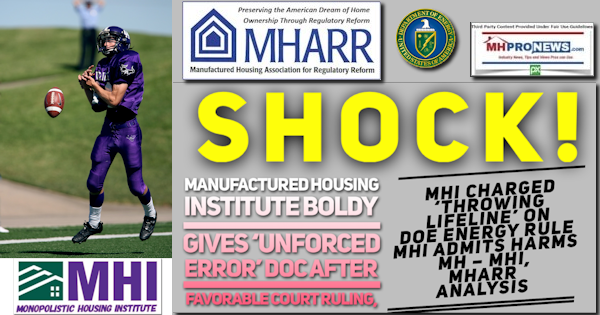
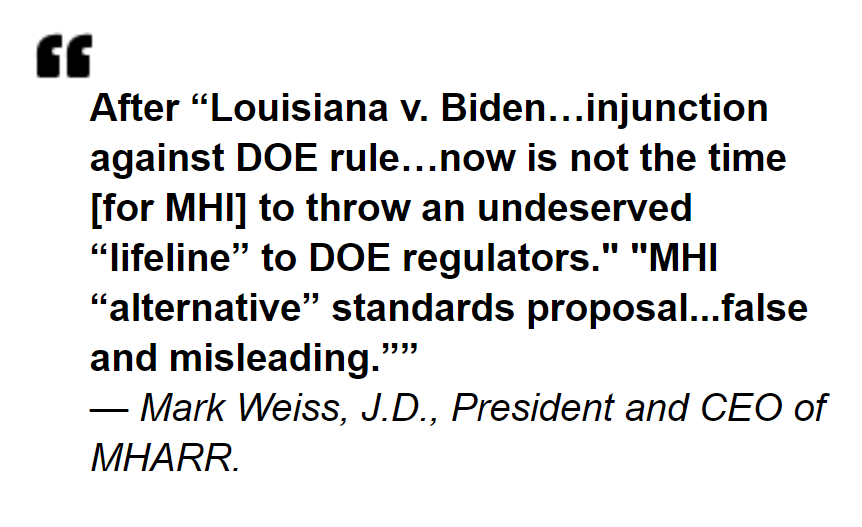
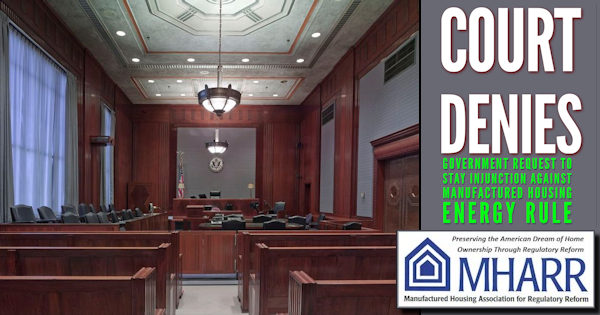
The pleadings above on behalf of MHI mention the Sierra Club suit of the DOE. What it doesn't clearly illustrate is that Warren Buffett, Chairman of Berkshire Hathaway which owns the largest manufactured home producer (Clayton Homes) and two of the largest lenders (21st Mortgage Corporations and Vanderbilt Mortgage and Finance). Buffett, as the report below documented on February 20, 2020, provides funding for the Sierra Club, as does periodic Buffett allies like Michael Bloomberg. Restated, this energy rule is pending in part due to that Sierra Club suit.
MHI is also failing to reveal that years earlier, they asked for negotiated rule making instead of flatly opposing the DOE energy rule, as MHARR has consistently done.
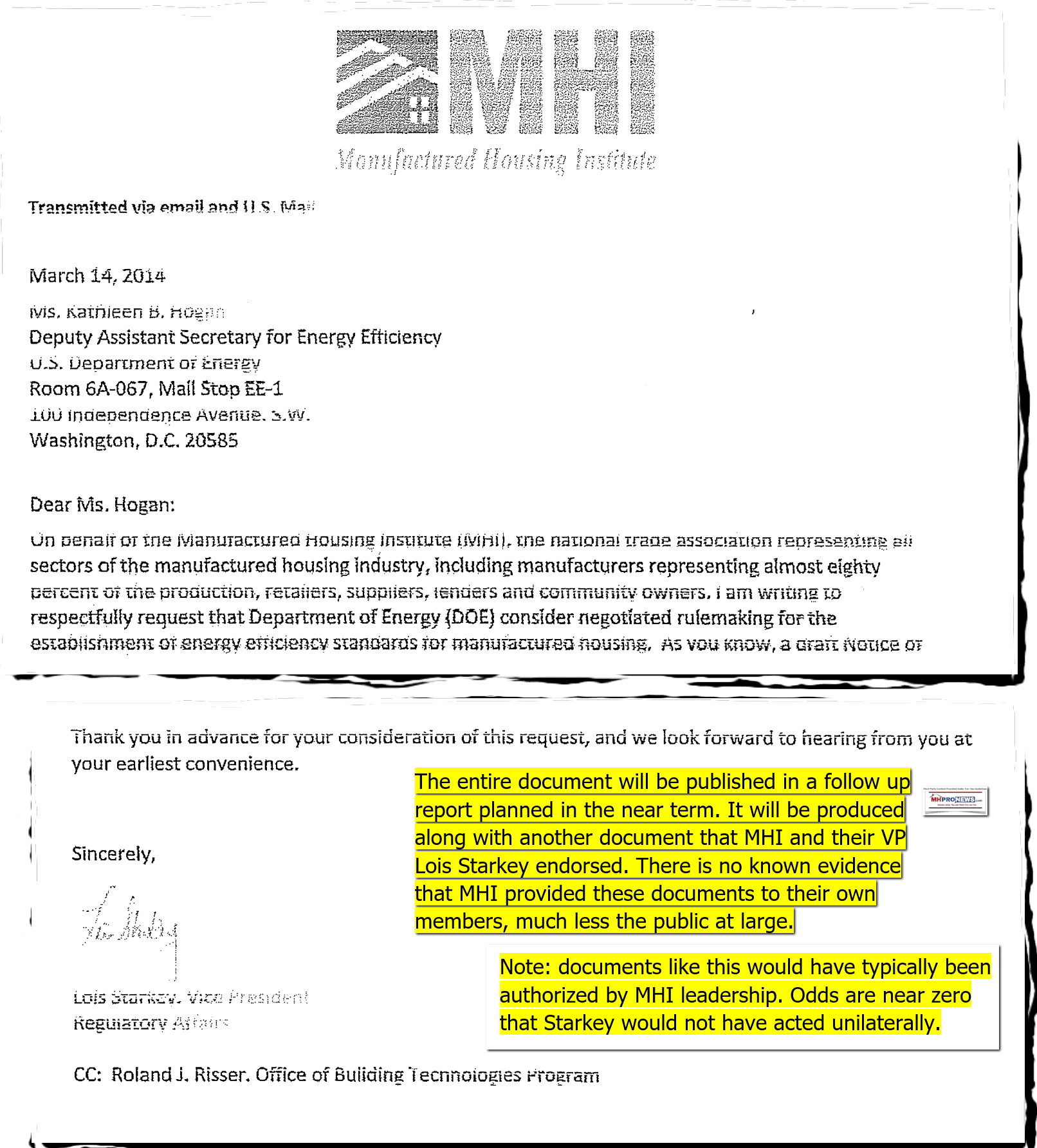
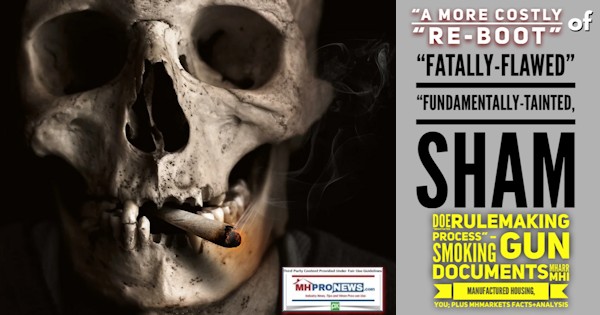
The item below was posted on October 15, 2021. The documents it contains make the case that MHI helped foster this rule before now opposing it.
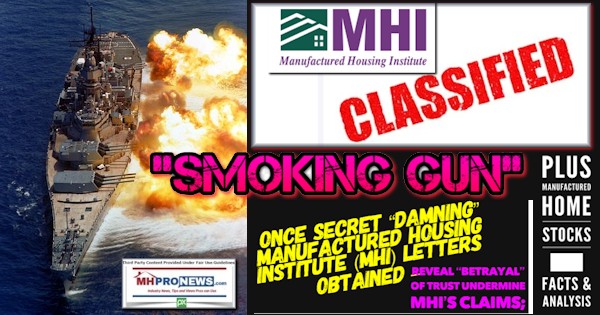
What could explain this duplicity? As the report linked below details, regulations are more harmful to smaller businesses than to larger ones.
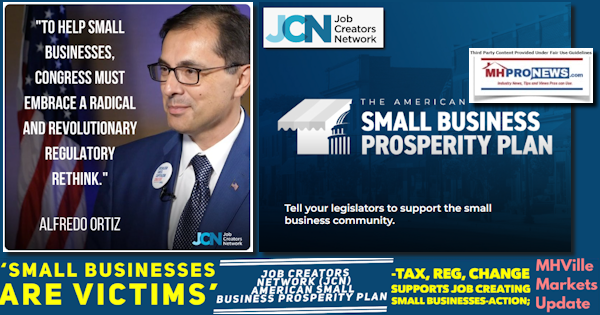
Several possibilities could be posited. Among them? MHARR's pushback and efforts, publicly supported by MHProNews and MHLivingNews, essentially forced them to pivot once again. Once again? Yes, see the report linked below.

But equally, or perhaps more importance is the following possibility. By allowing the DOE energy rule to advance, MHI may have put indirect pressure (de facto using regulators) on independents to sell out. Who do they sell out to? Isn't it obviously routinely to Clayton Homes (BRK), Skyline Champion (SKY), and Cavco Industries (CVCO)? Note that all of those are MHI members. If that sounds conspiratorial, one need not look further than the SEC pleadings in their case against Cavco. It documented something that WAS a conspiracy.
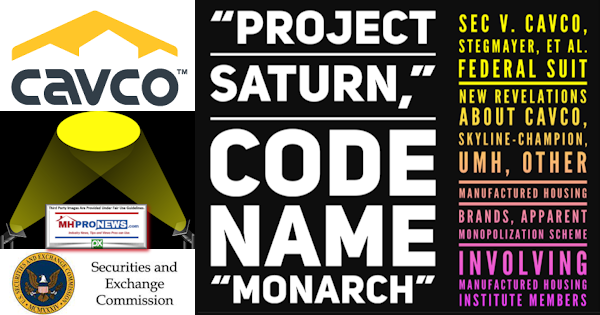
Keep in mind that Cavco settled that case for 7 figures. Meanwhile, Cavco acquired a number of independents. Is that a coincidence when costly regulatory threats rule?

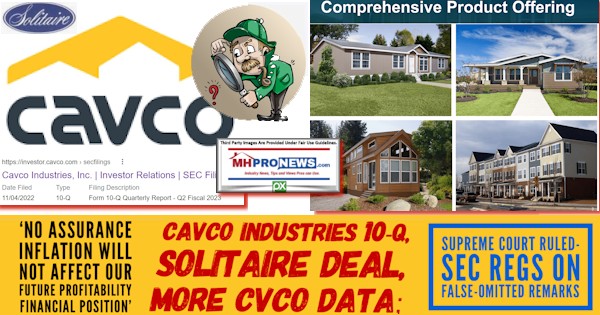

These and other acquisitions have occurred during the timeframe that the DOE energy rule, and other regulatory woes, have dogged the manufactured housing industry. It would require a forensic audit of the records of the discussions to see how many fingerprints of these regulatory barriers impacted those decisions by independents.
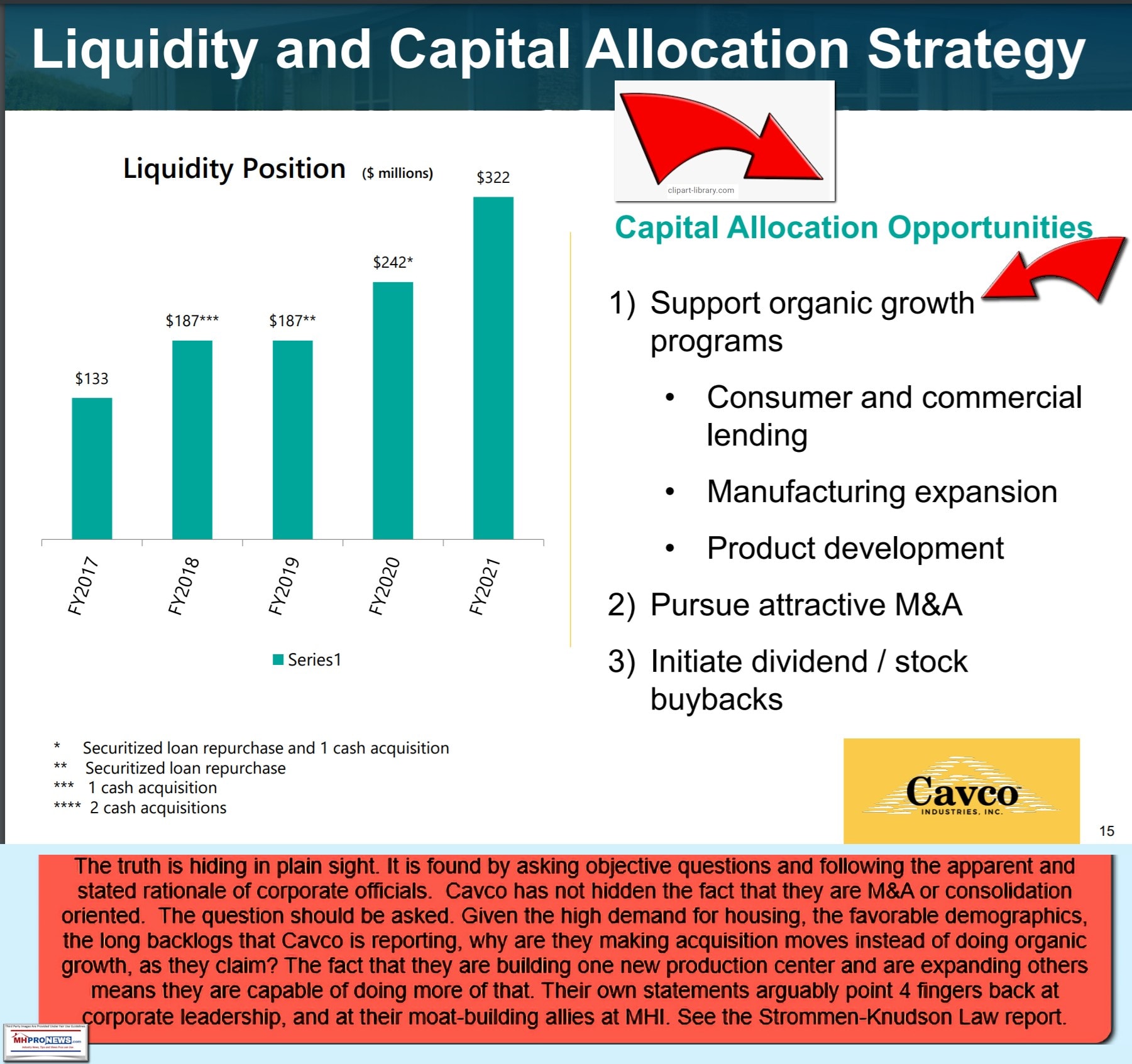
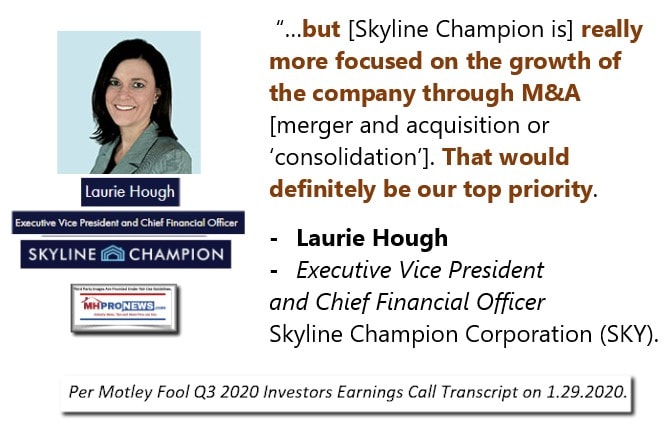
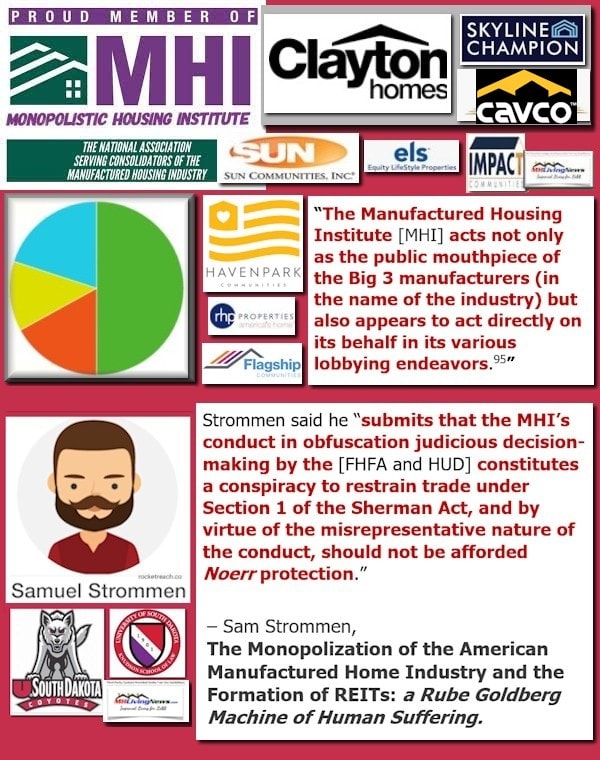
MHI and their corporate masters may now have a new challenge. Given that they have finally filed suit on this issue, what excuse will they give for not doing so on the Manufactured Housing Improvement Act of 2000 (MHIA) and its largely unenforced enhanced preemption rule? What excuse will MHI give for not filing suit to force FHFA to enforce the Duty to Serve (DTS) manufactured home lending enacted by Congress in the Housing and Economic Recovery Act (HERA of 2008? Ooops.

These are all reasons for Congress, and or private attorneys, perhaps working on behalf of shareholders, to probe the manufactured housing industry.
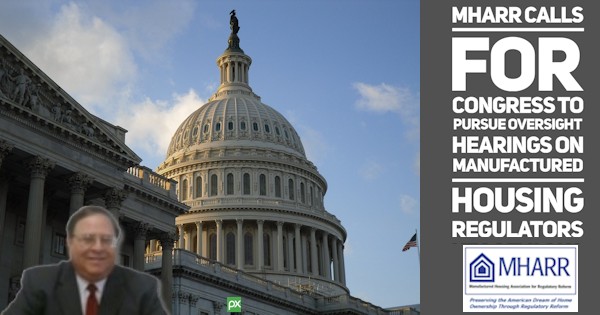
No Title
No Description
'Manufactured Housing Closes Year on Cool Note, But Optimism Grows for 2023' Says TRERC, But TMHA VP Rob Ripperda Lets Cat Out of Proverbial Bag, Exposing MHI; plus MHVille Market, Stocks Update
'Manufactured Housing Closes Year on Cool Note, But Optimism Grows for 2023' Says TRERC, Texas Manufactured Housing Association, TMHA, TMHA VP Rob Ripperda, Statement, Lets Cat Out of Proverbial Bag, Exposing MHI, plus MHVille Market, Stocks Update, retail, suppliers, finance, brokers, production, factories, dealers, communities, manufactured home communities, mobile home parks,
There are several twists and turns that are likely ahead on this litigation. It could be a good thing for manufactured home independents, consumers, and taxpayers. For more insights, see the linked and related reports. MHProNews will plan to monitor and update as deemed warranted. ###
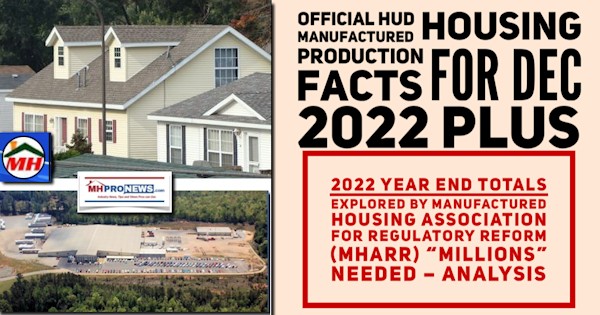

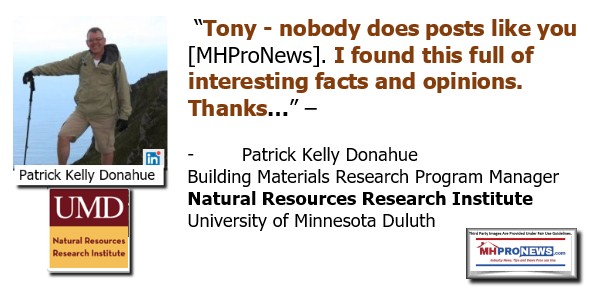
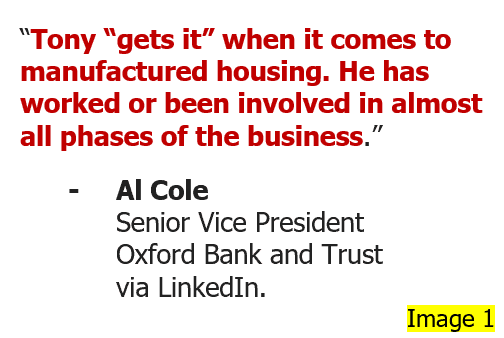
[cp_popup display="inline" style_id="139941" step_id = "1"][/cp_popup]
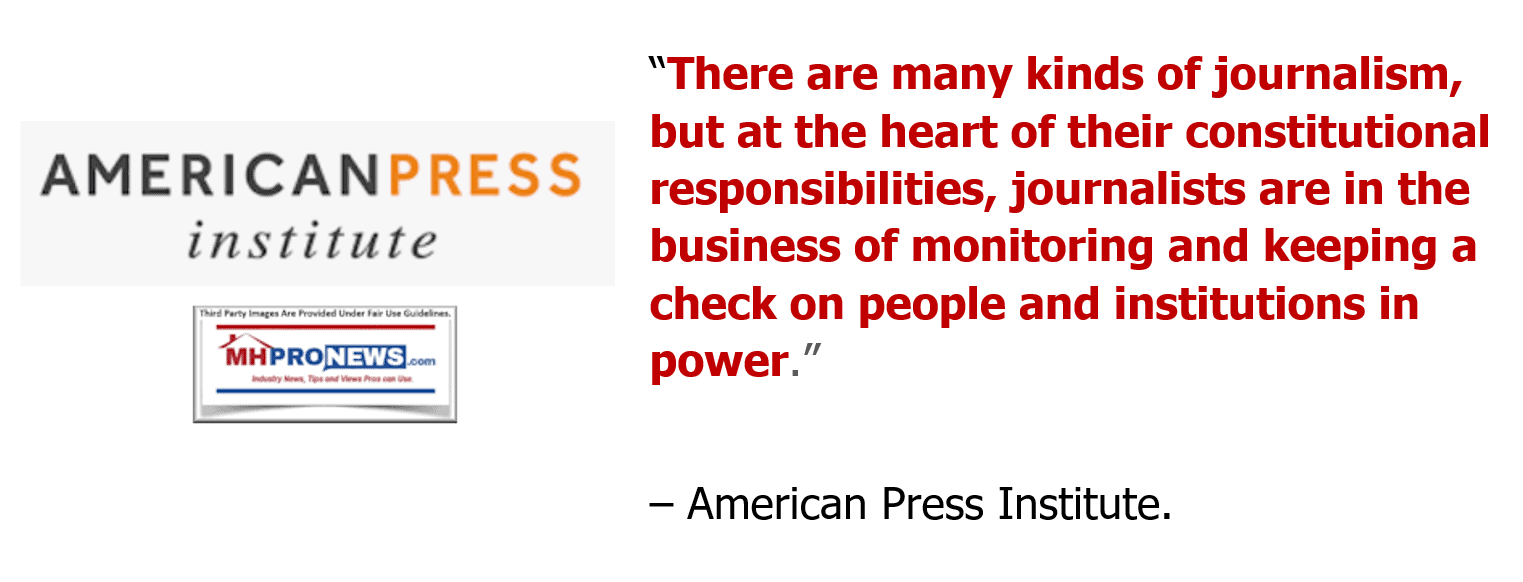
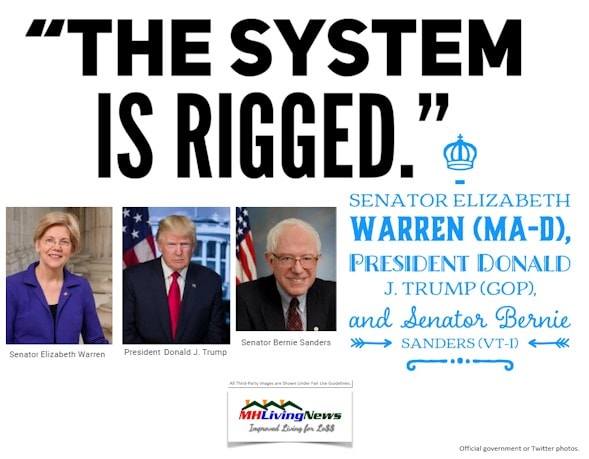
Stay tuned for more of what is 'behind the curtains' as well as what is obvious and in your face reporting that are not found anywhere else in MHVille. It is all here, which may explain why this is the runaway largest and most-read source for authentic manufactured home “News through the lens of manufactured homes and factory-built housing” © where “We Provide, You Decide.” © ## (Affordable housing, manufactured homes, reports, fact-checks, analysis, and commentary. Third-party images or content are provided under fair use guidelines for media.) (See Related Reports, further below. Text/image boxes often are hot-linked to other reports that can be access by clicking on them.)
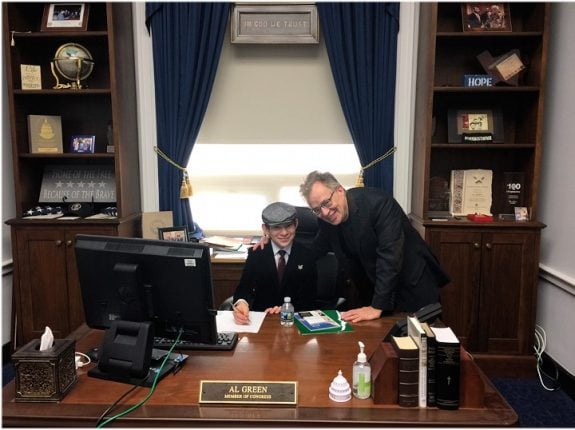
By L.A. "Tony" Kovach - for MHProNews.com.
Tony earned a journalism scholarship and earned numerous awards in history and in manufactured housing.
For example, he earned the prestigious Lottinville Award in history from the University of Oklahoma, where he studied history and business management. He's a managing member and co-founder of LifeStyle Factory Homes, LLC, the parent company to MHProNews, and MHLivingNews.com.
This article reflects the LLC's and/or the writer's position, and may or may not reflect the views of sponsors or supporters.
Connect on LinkedIn: http://www.linkedin.com/in/latonykovach
Related References:
The text/image boxes below are linked to other reports, which can be accessed by clicking on them.

